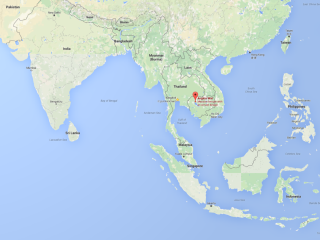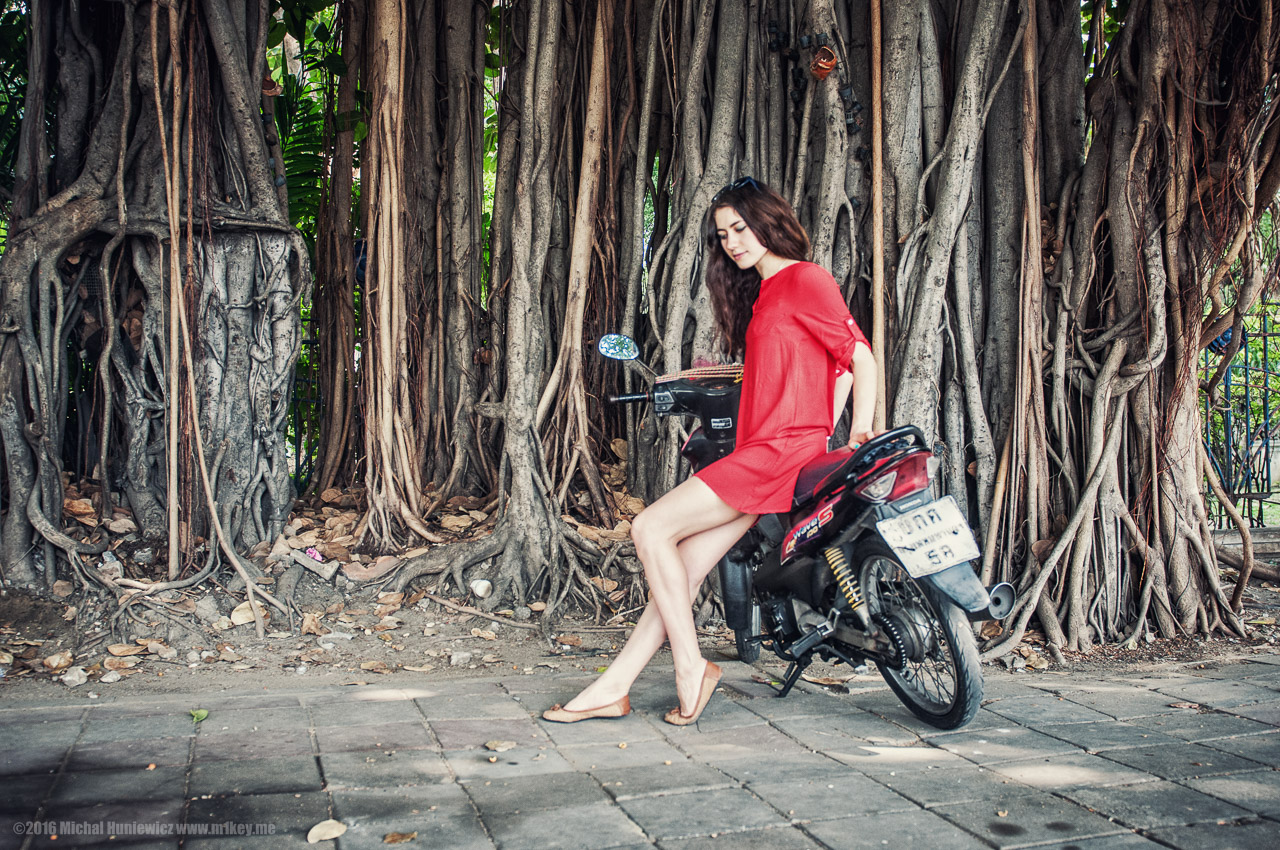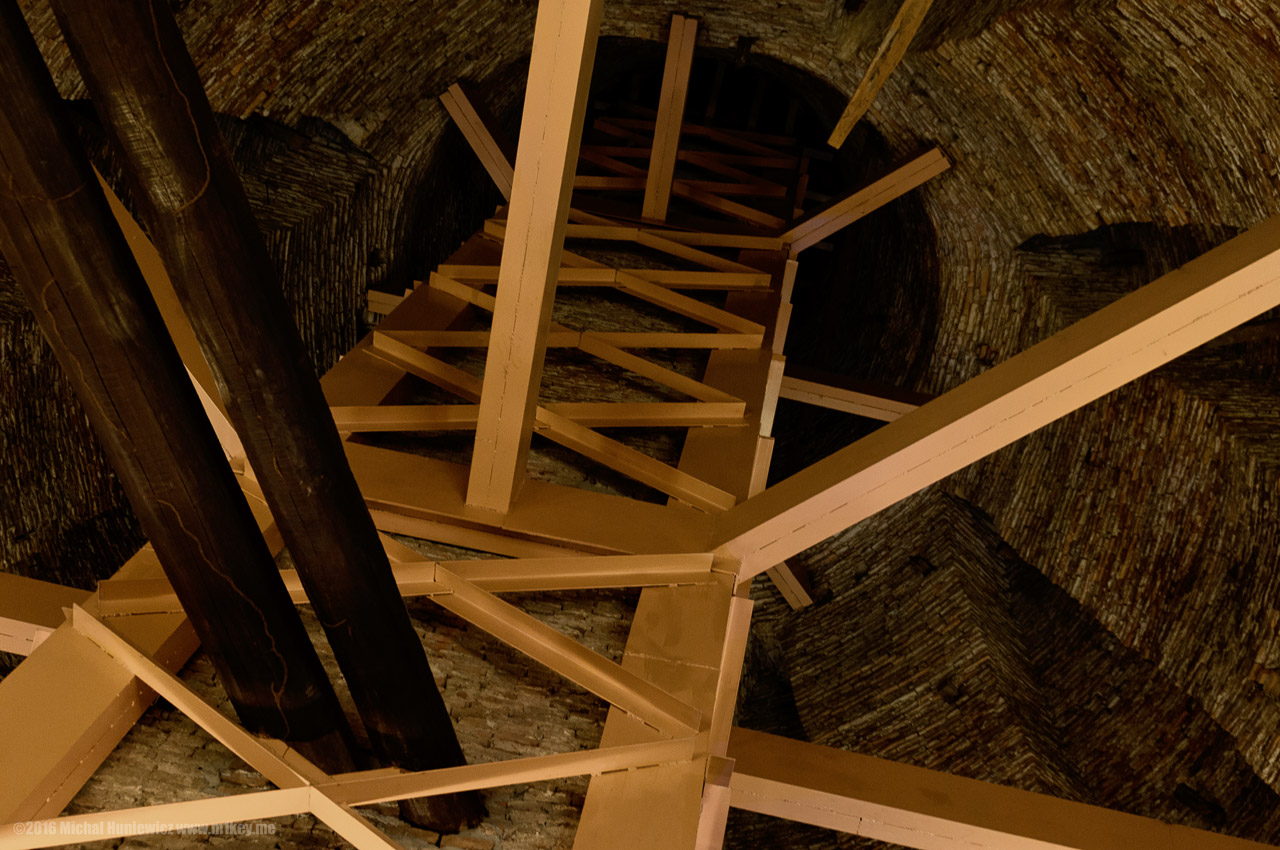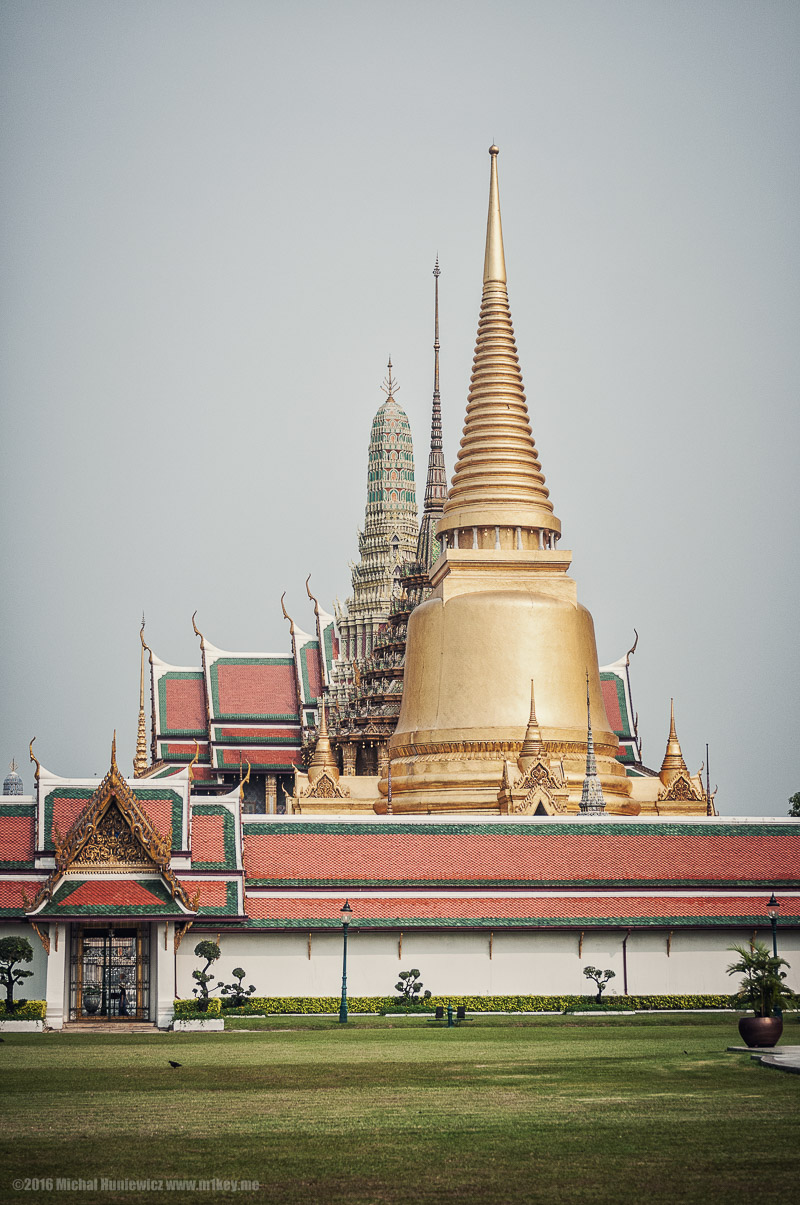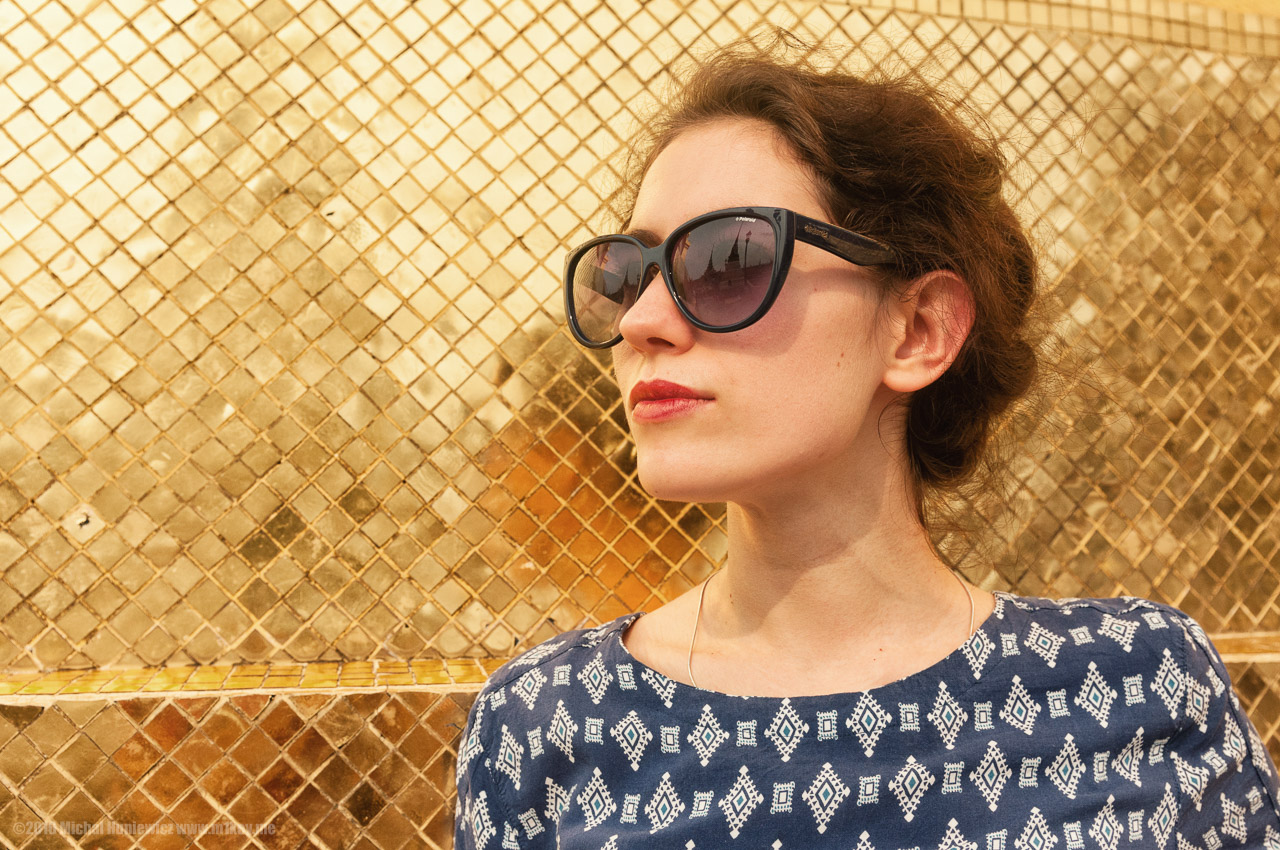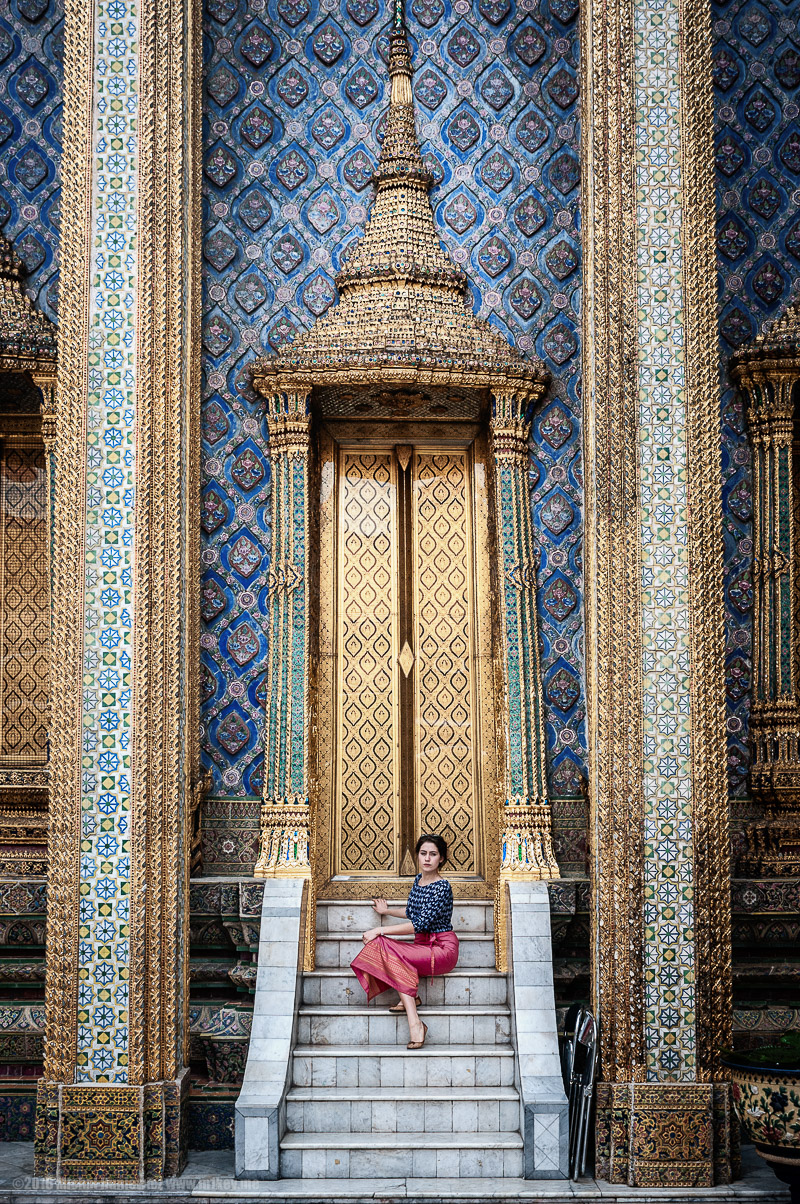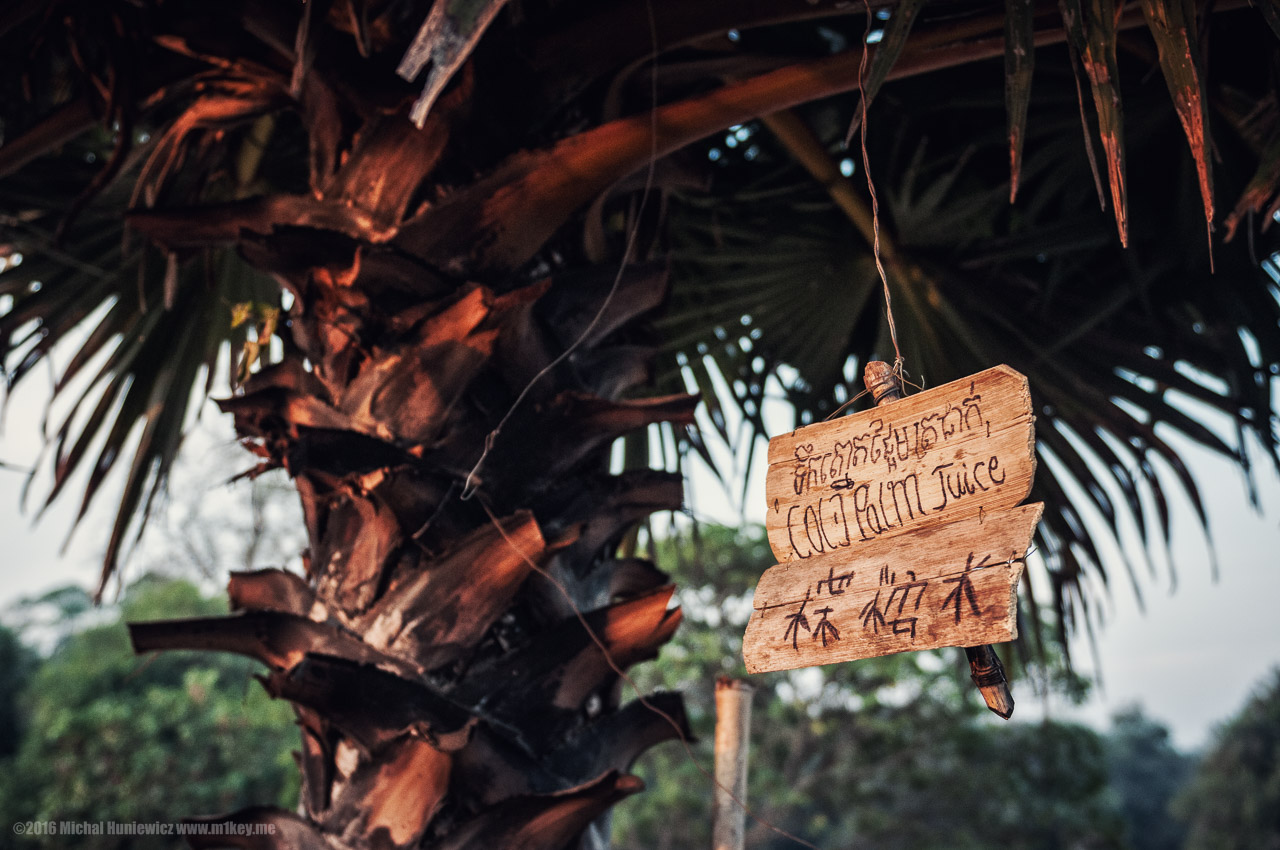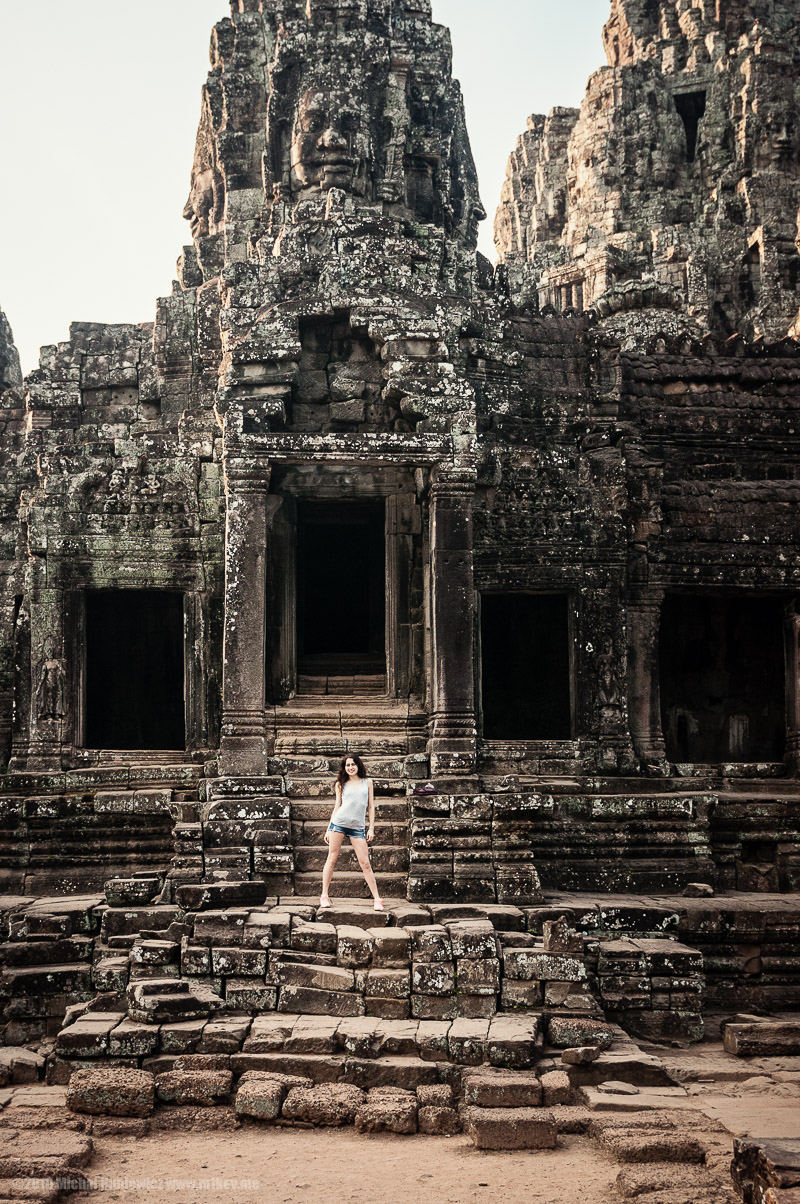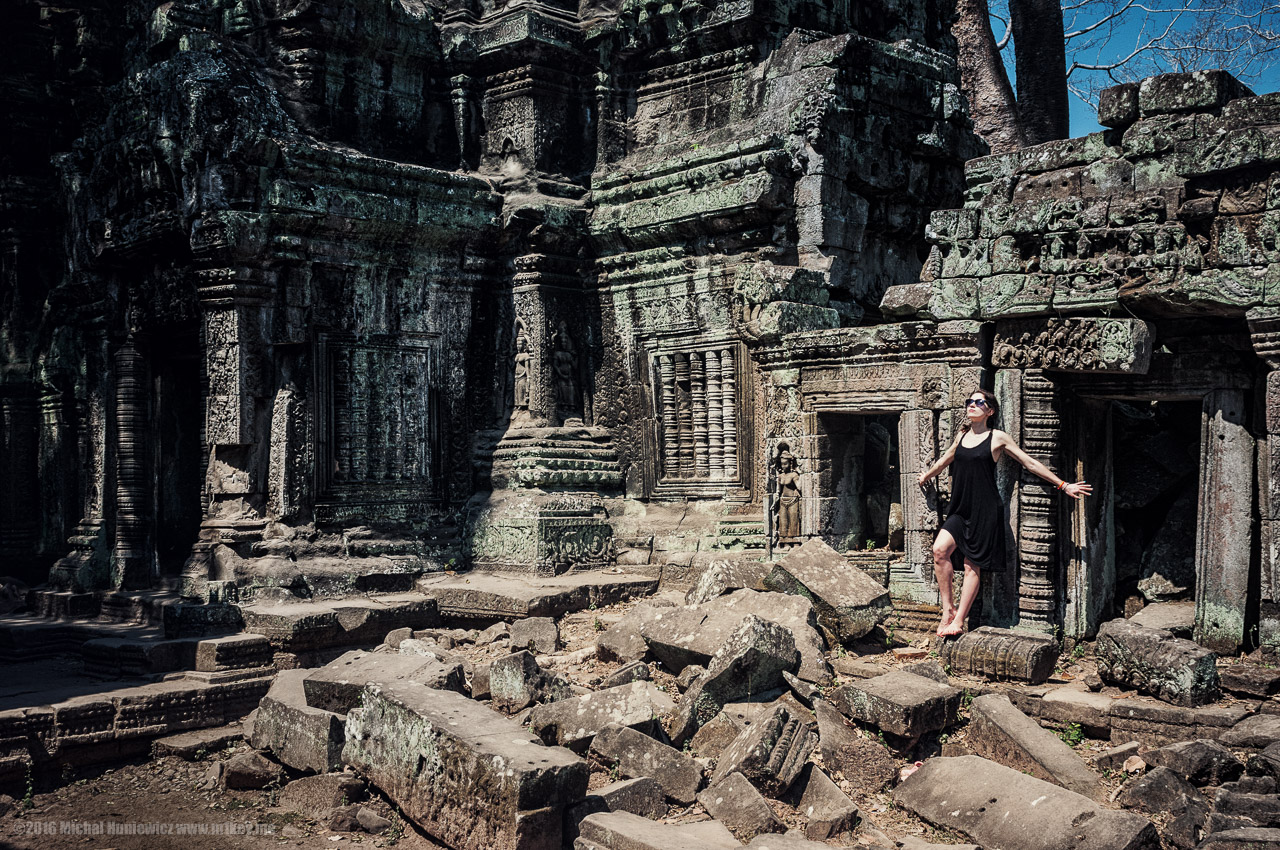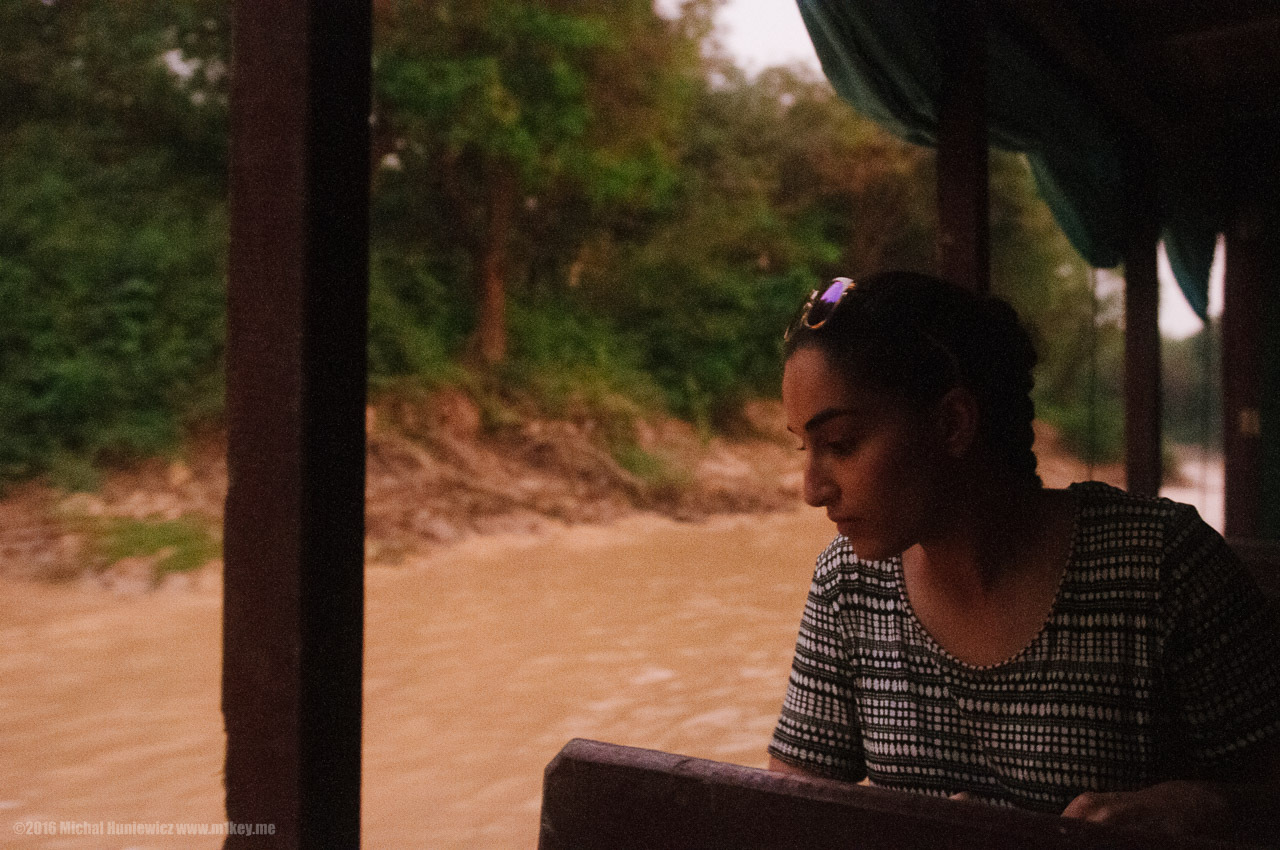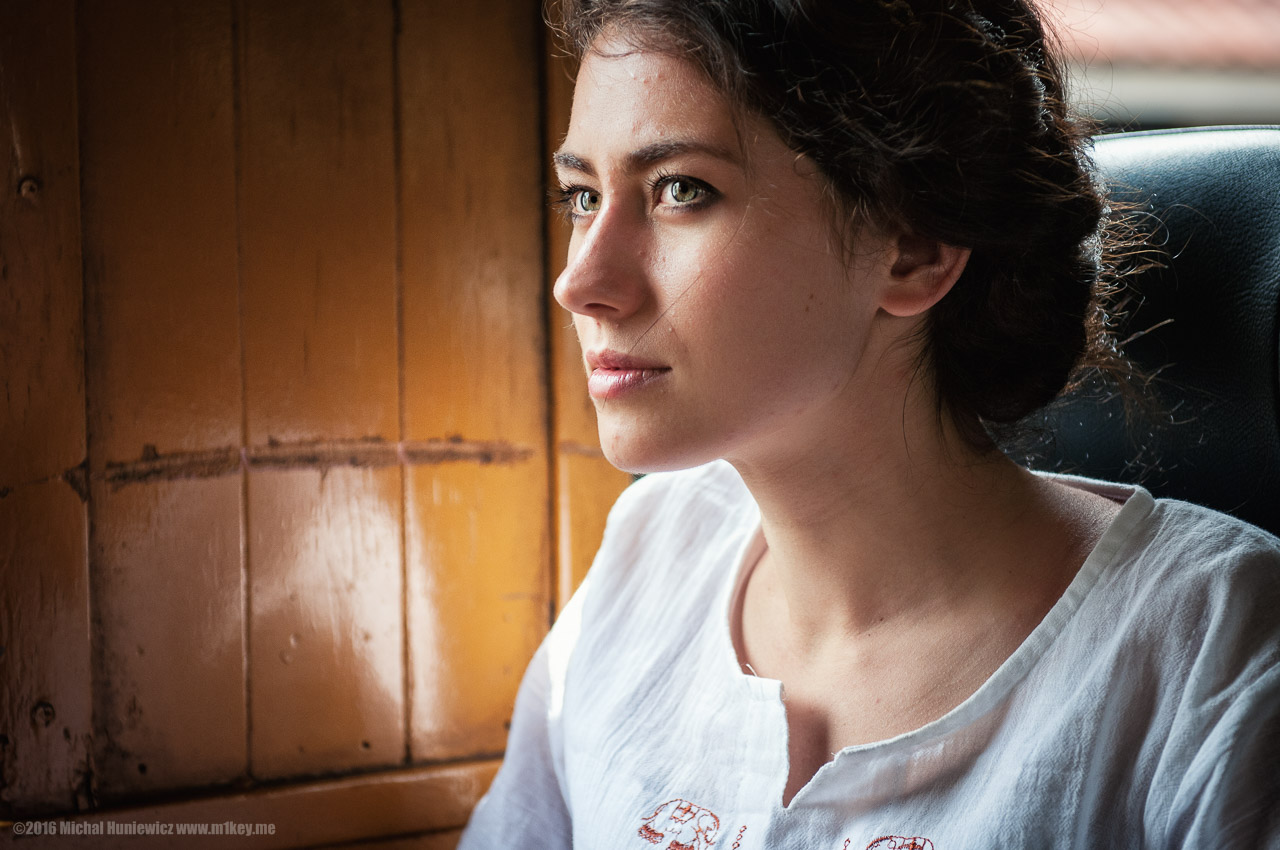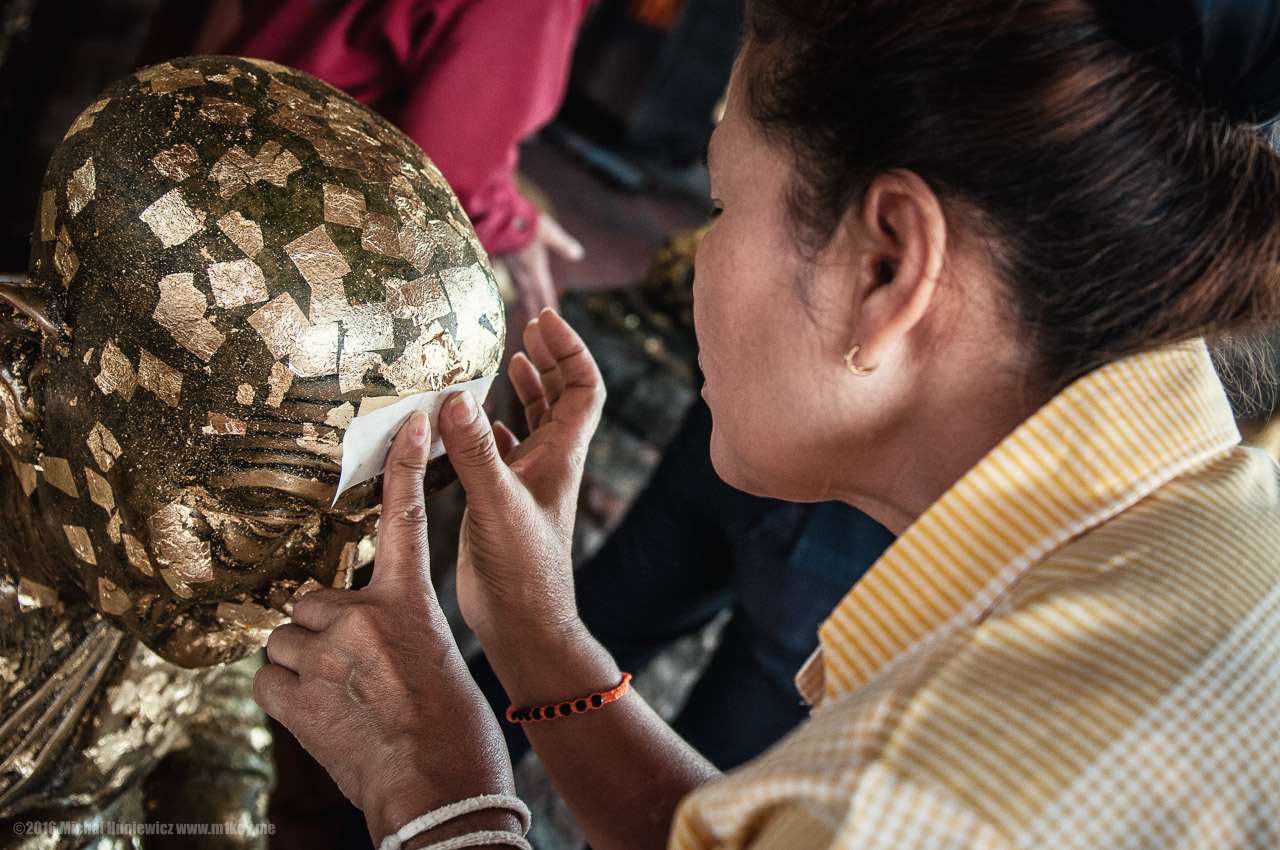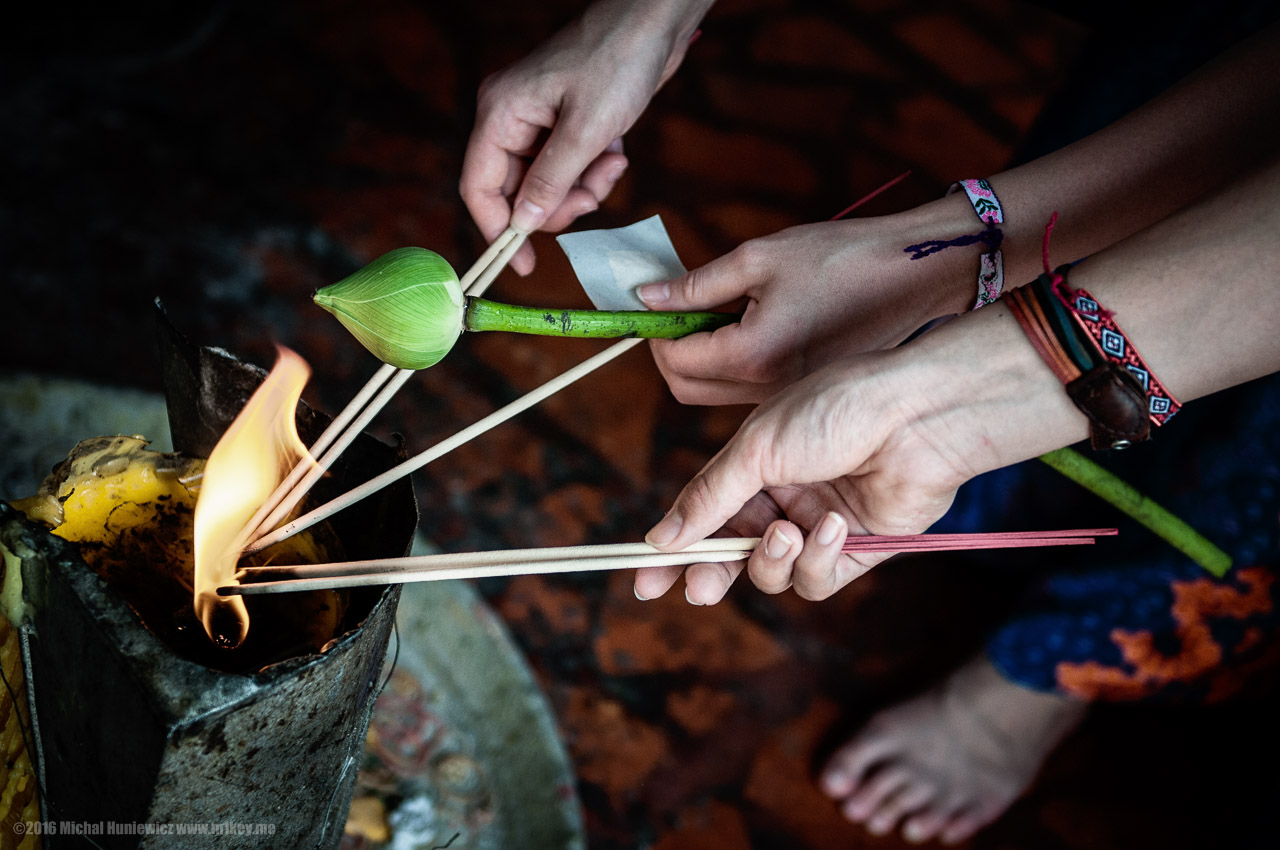Thailand & Cambodia Photography - M1key - Michal Huniewicz

A bunch of shots from my trip to Thailand and Cambodia. I have provided some historical information to put things into place, and allow you as much as myself to understand the two states, as I was largerly ignorant of Southeast Asia as a whole.
If you liked this gallery, you can follow me on Twitter or Facebook, or even Instagram, much appreciated.
Sources:
1,
2,
3,
4,
5,
6,
7,
8,
9,
10,
11,
12,
13,
14,
15,
16,
17,
18,
19,
20,
21.
Uploaded on: 2016-07-10.
Buddha
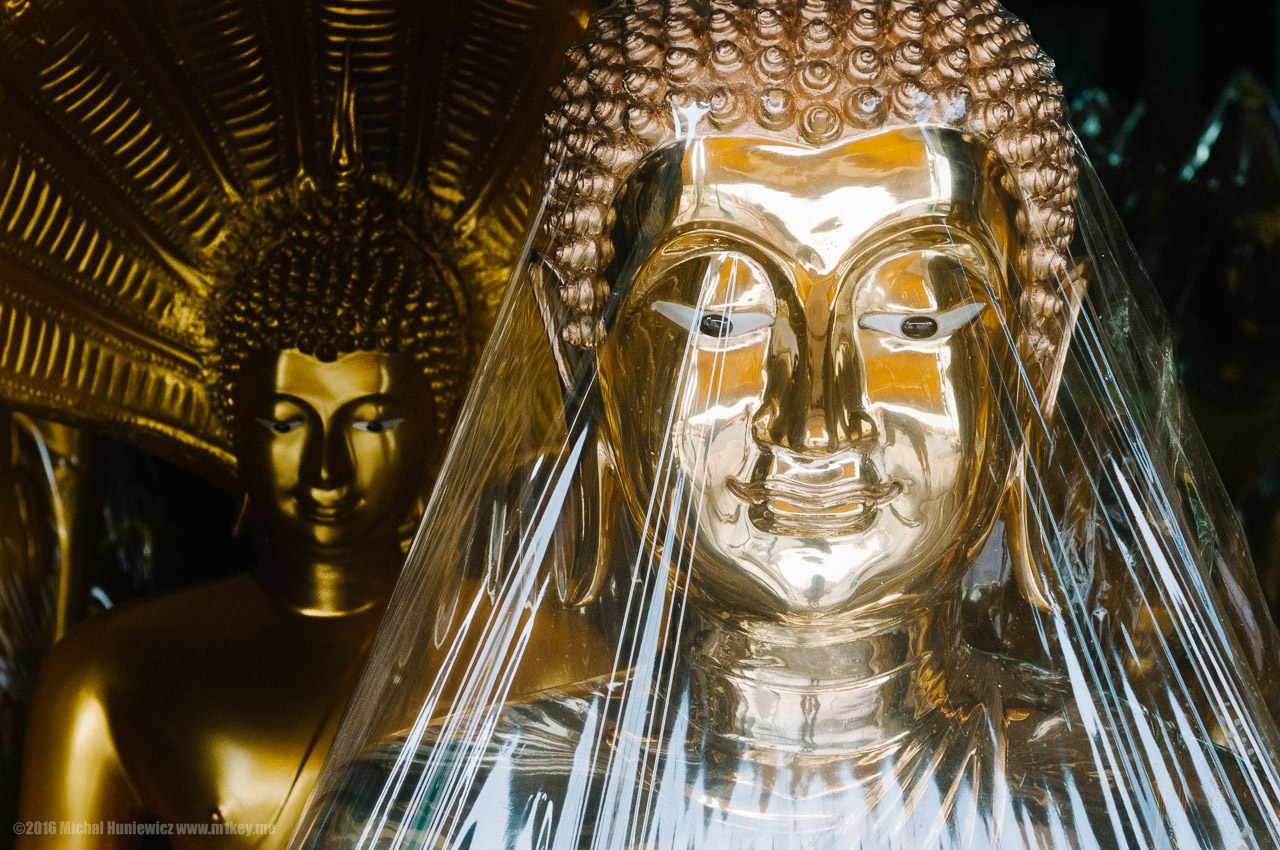
A statue of Buddha on sale in Bangkok. Buddhism is the dominant religion of both Thailand and Cambodia.
This picture was taken in Bangkok, and the full name of Bangkok is "the city of angels, the great city, the residence of the Emerald Buddha, the impregnable city (unlike Ayutthaya) of God Indra, the grand capital of the world endowed with nine precious gems, the happy city, abounding in an enormous Royal Palace that resembles the heavenly abode where reigns the reincarnated god, a city given by Indra and built by Vishnukarn".
This picture was taken in Bangkok, and the full name of Bangkok is "the city of angels, the great city, the residence of the Emerald Buddha, the impregnable city (unlike Ayutthaya) of God Indra, the grand capital of the world endowed with nine precious gems, the happy city, abounding in an enormous Royal Palace that resembles the heavenly abode where reigns the reincarnated god, a city given by Indra and built by Vishnukarn".
ISO 200, 45mm, f/5.6, 1/80s.
Guardian
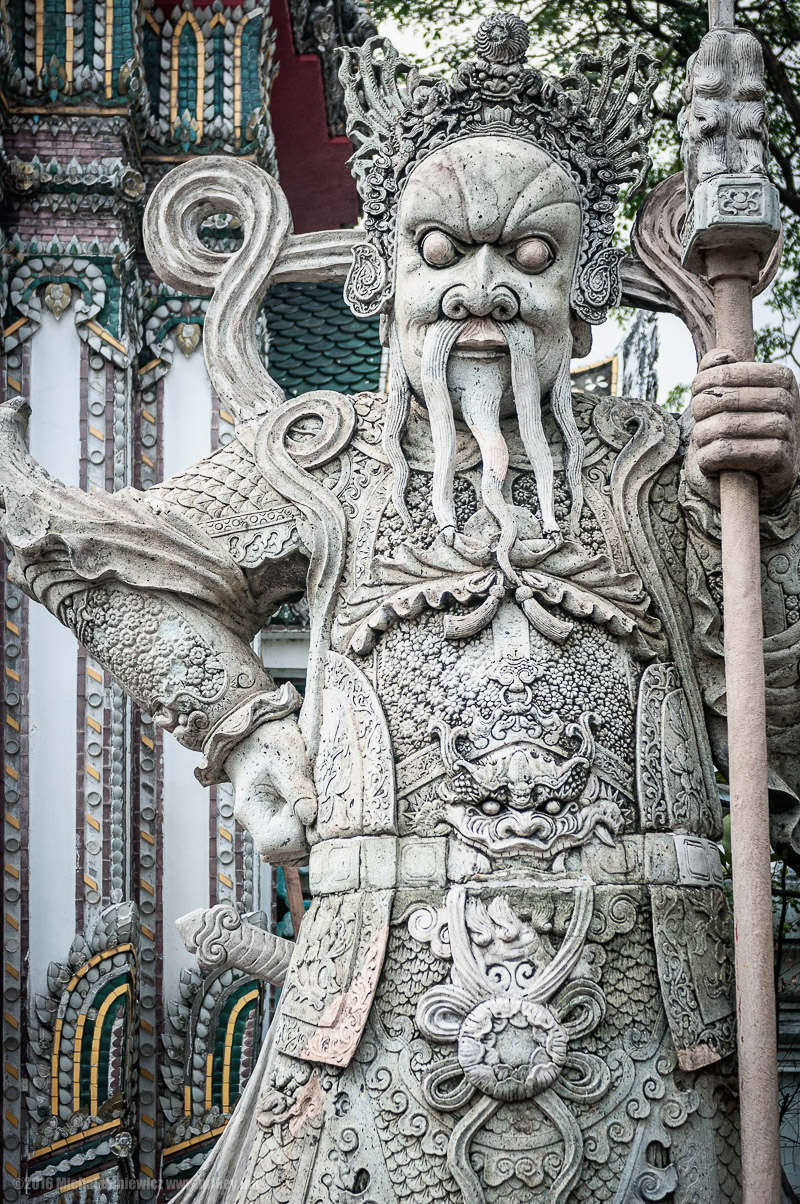
A guardian statue in the Wat Pho temple. Thailand is located in Southeast Asia, mainland - previously known as Indochina. As other countries in that region, it has some Indian and Chinese influence, the Indian one being dominant (unlike in, say, Vietnam, where the culture is more Chinese). Thailand is especially interesting, because it's never been a Western colony. [2] This guardian, however, displays Chinese influence.
ISO 200, 48mm, f/2.8, 1/1000s.
Ubosot
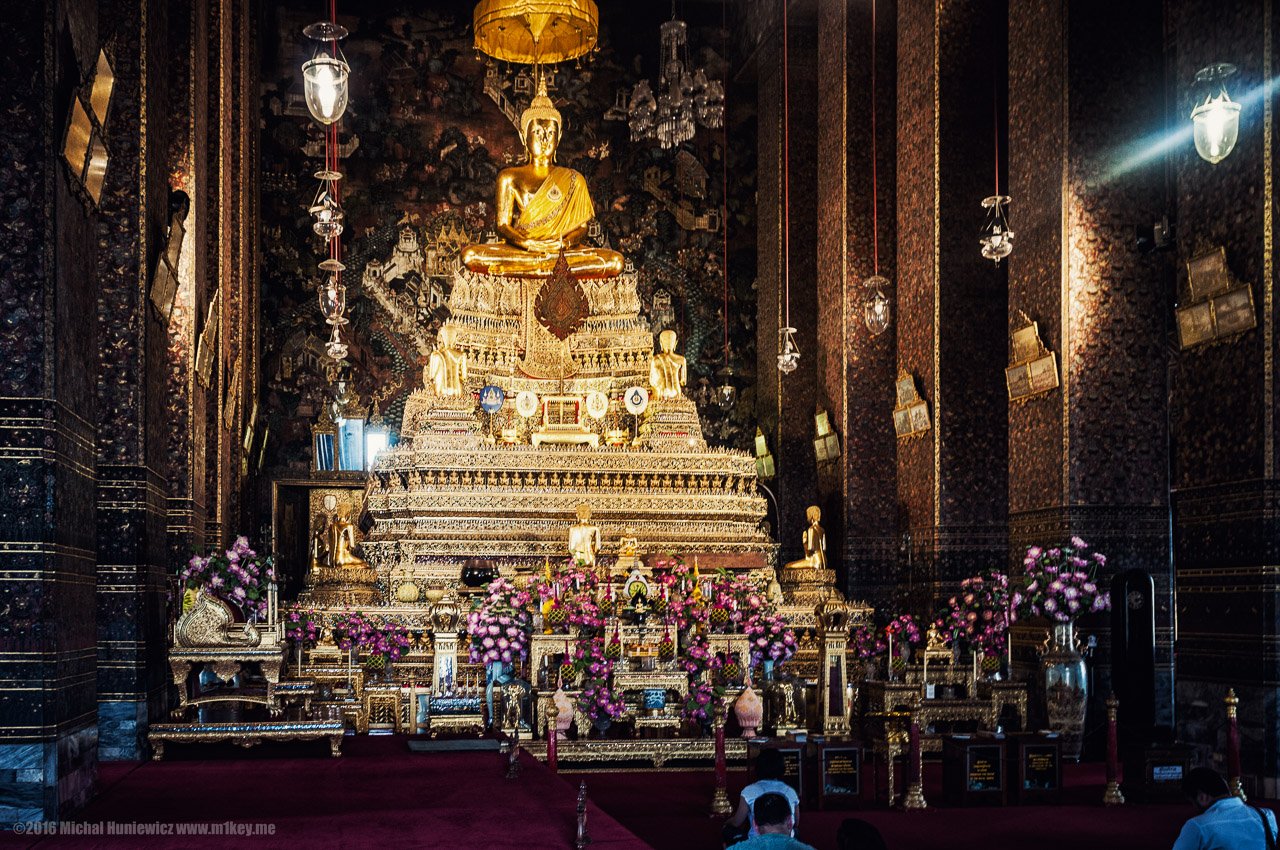
Why was Thailand never colonised by the West? Simply because the French and the British designated it as the buffer zone. [16]
The temple is known as the birthplace of traditional Thai massage. [1] Not the kind of massage I almost received in Cambodia...
The temple is known as the birthplace of traditional Thai massage. [1] Not the kind of massage I almost received in Cambodia...
ISO 200, 24mm, f/4.5, 1/6s.
Wat Pho
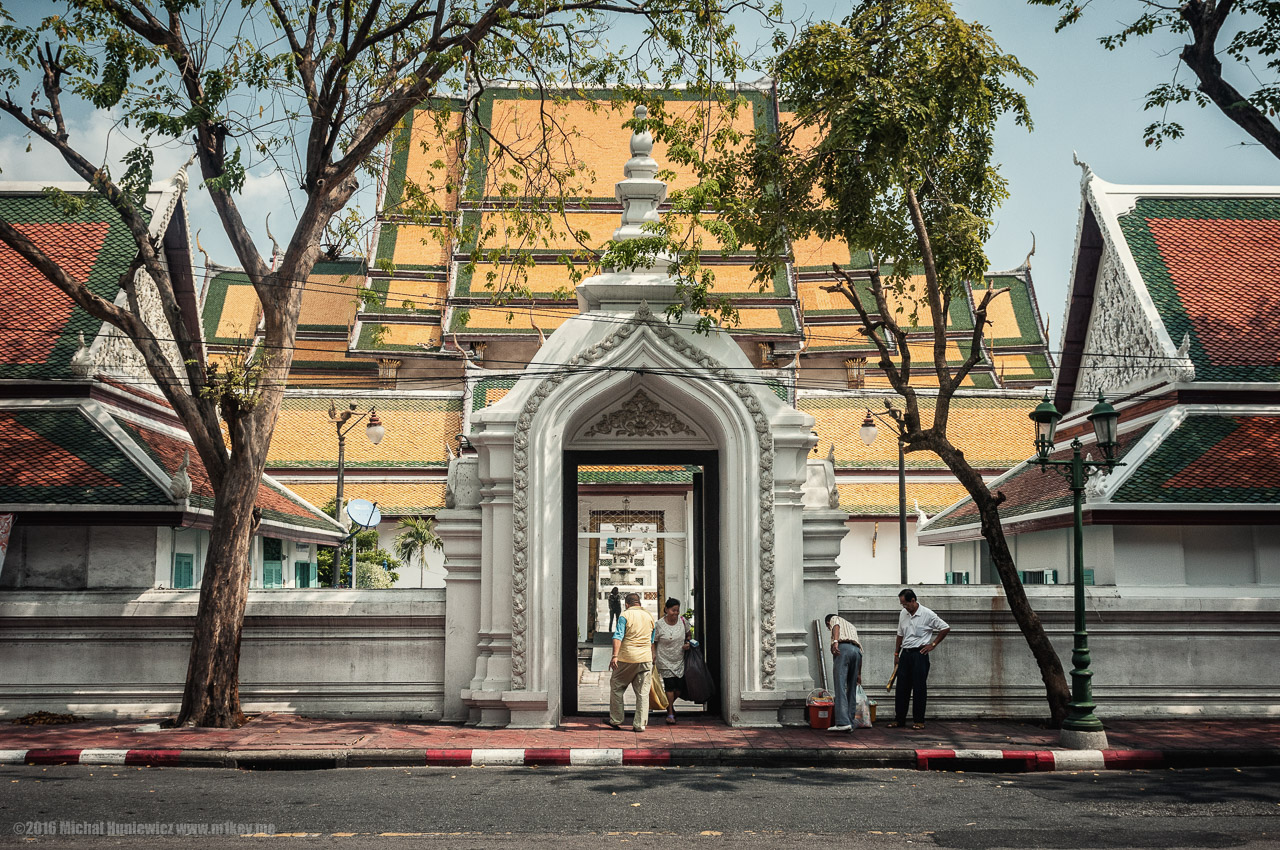
With an area of 80,000 square metres, Wat Pho is one of the largest wats in Bangkok. What's a wat?, I hear you ask. Wat in Thailand simply means a Buddhist temple. [3]
ISO 200, 24mm, f/5.6, 1/500s.
Ksenia
Chedi
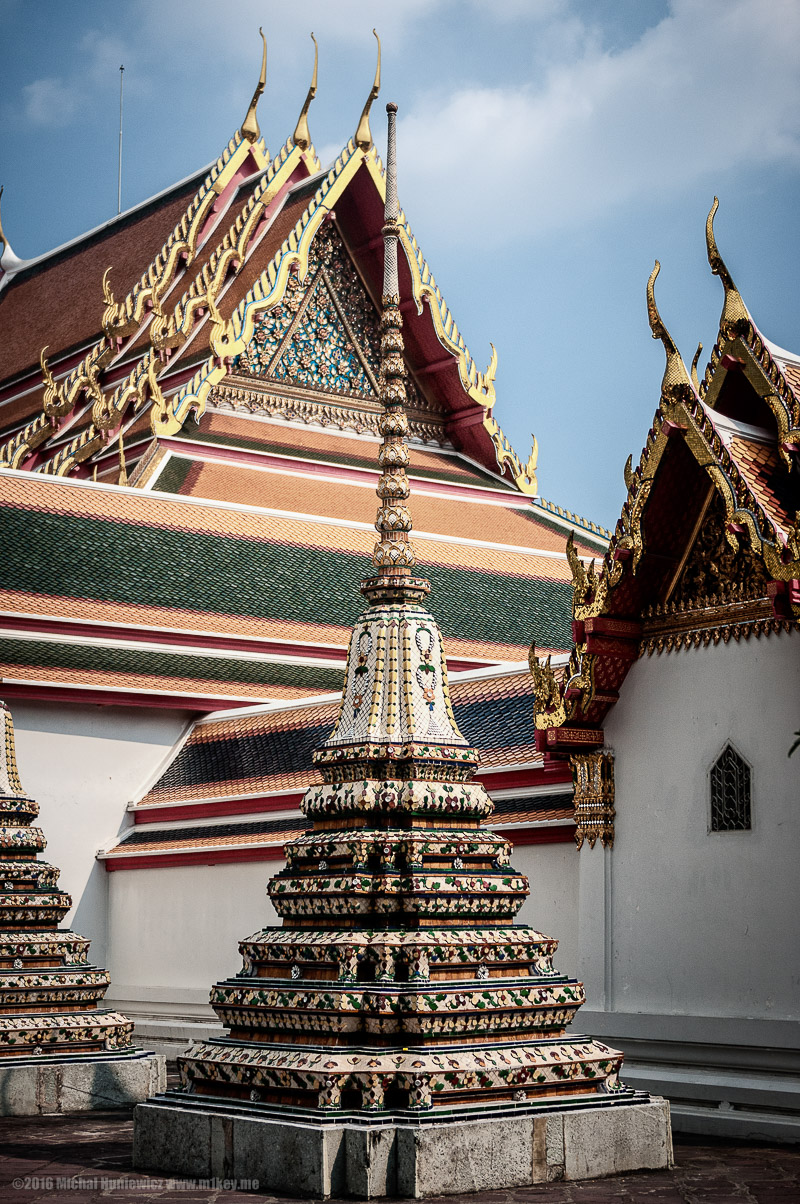
These are known as chedis. Chedi is an alternative term for Buddhist stupa (see below), mainly used in Thailand. [4]
ISO 200, 36mm, f/2.8, 1/3200s.
Mr. Savong Kontong
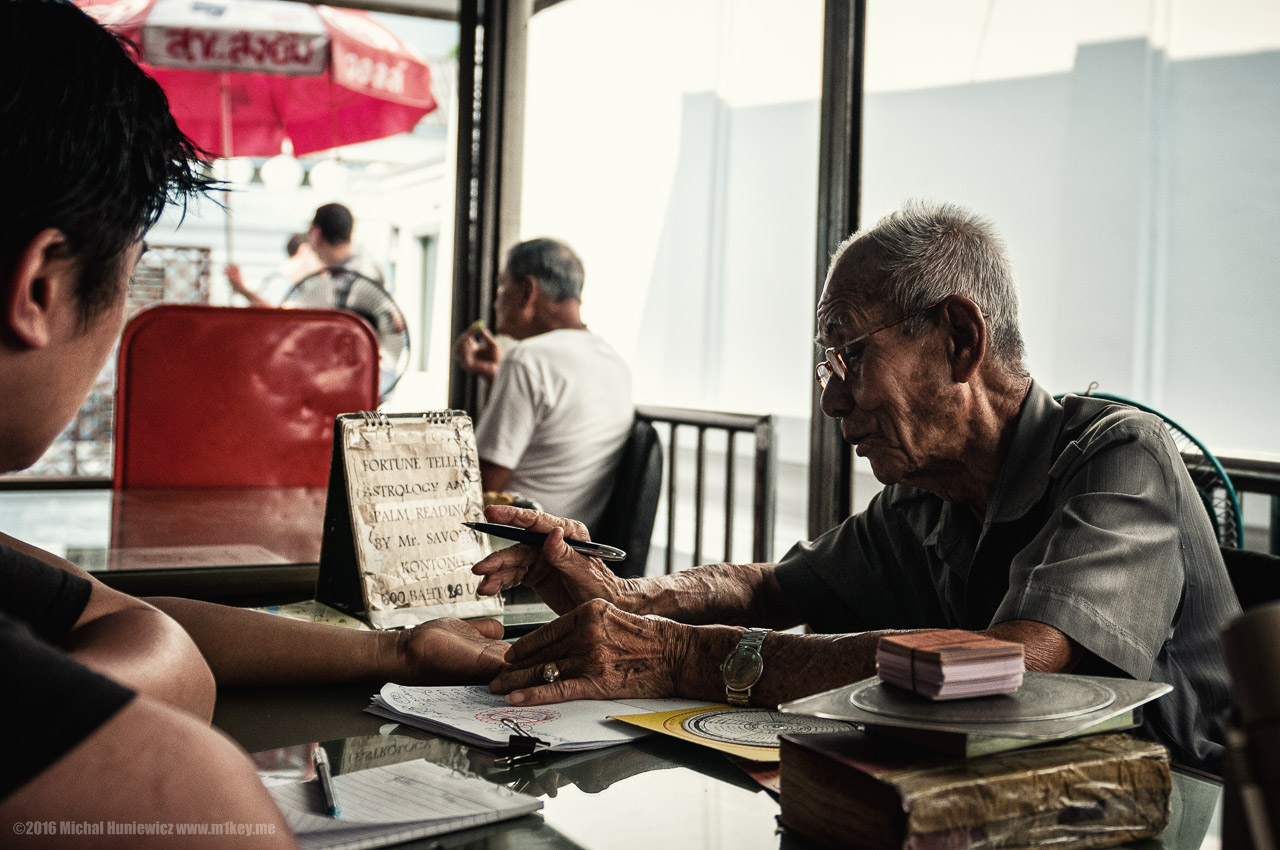
This guy is Mr. Savong Kontong, 87, and he's a fortune teller. Thailand is highly superstitious! I'm generally sceptical about superstitions, and the closest I get to being supersitious is attaching UV filters to my lenses. Here's an interesting Thai weirdness I found on CNN: "Wooden phalluses, however, are collected by superstitious people seeking a sperm-boosting icon, including women hoping to get pregnant, prostitutes wishing for randy customers, and would-be playboys." [5]
ISO 200, 24mm, f/2.8, 1/2000s.
Sok Sabai!
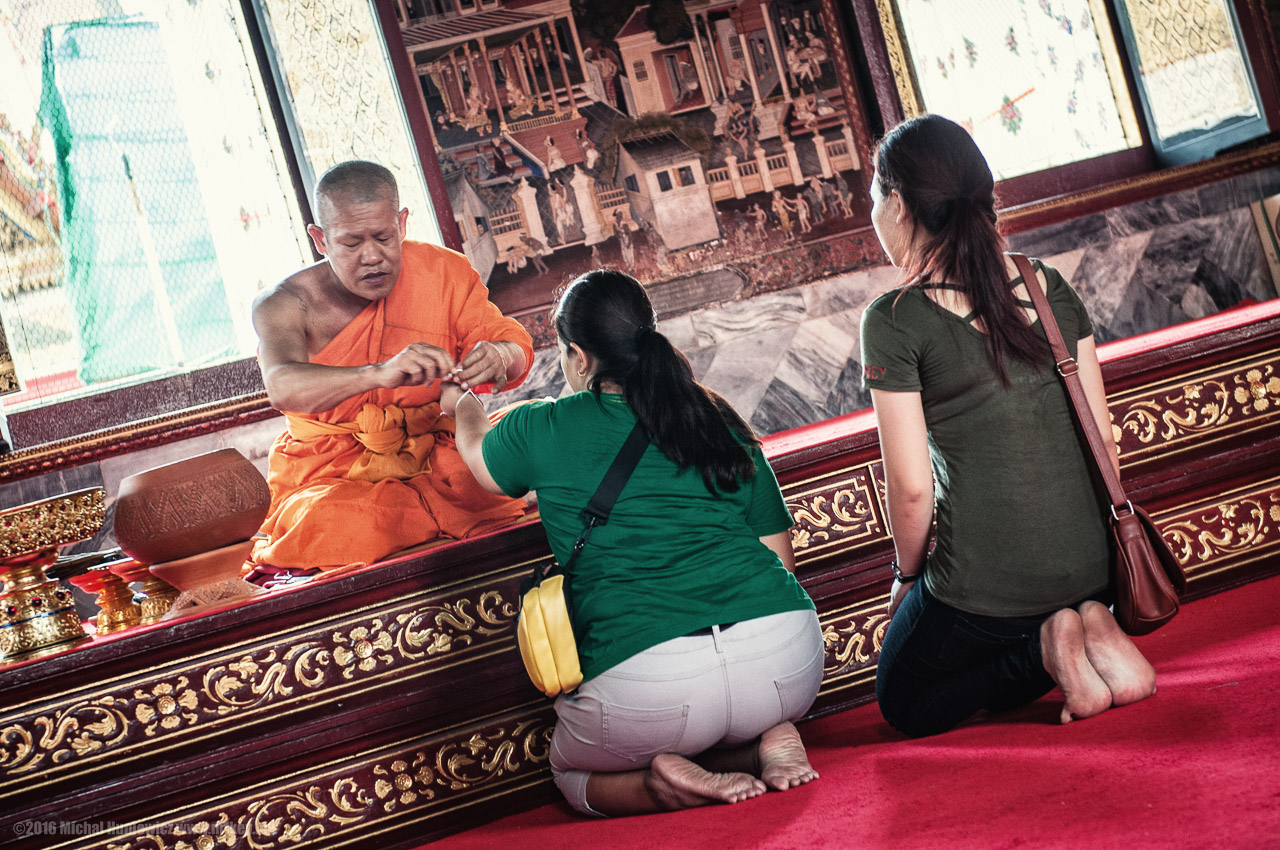
Monk blessing two women, putting bracelets on their wrists that are meant to remind people to show compassion to others, apparently. [7] We got those bracelets as well, and in Cambodia they would say "Sok Sabai!", which I thought had some sort of profound meaning, but apparently it means "fine, thank you"...? [6]
ISO 200, 56mm, f/3.5, 1/50s.
Wat Arun
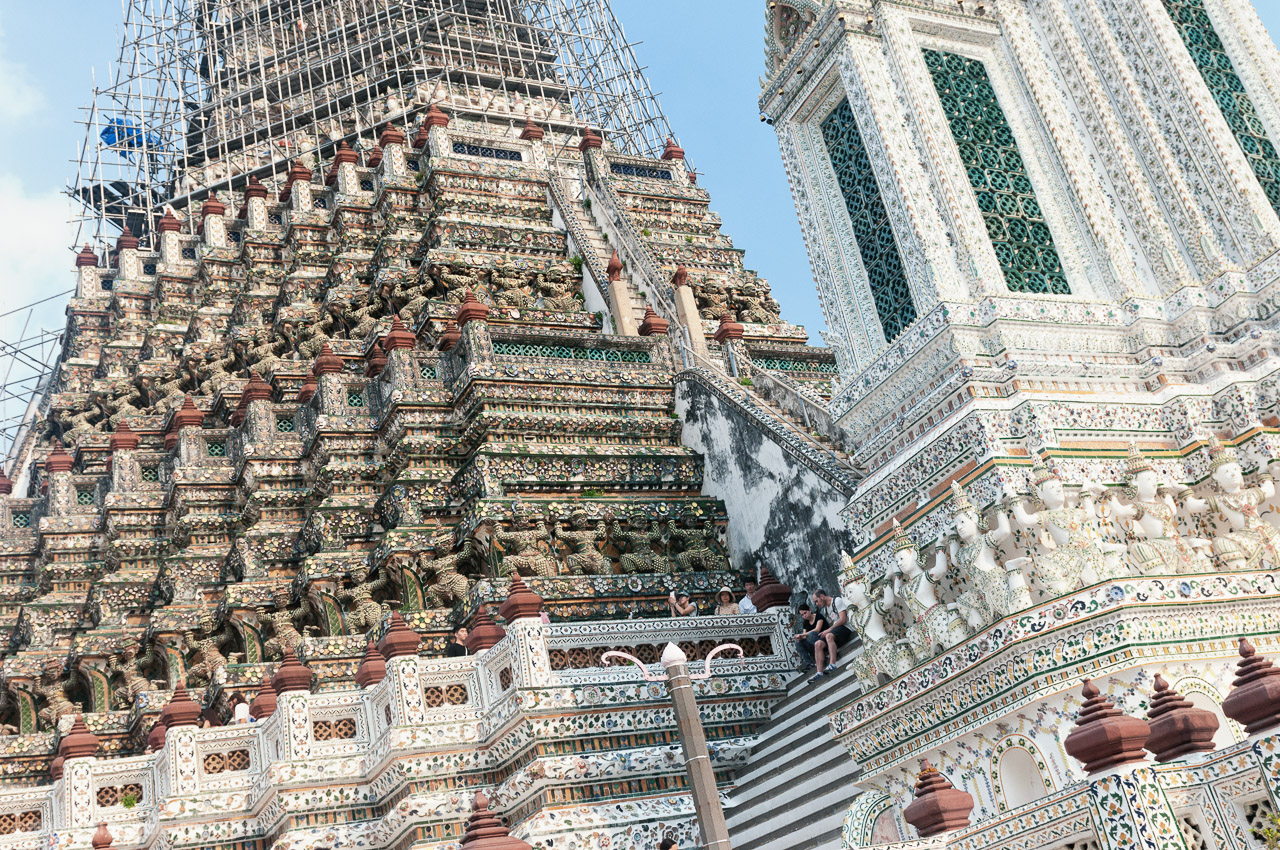
Wat Arun, named after the Hindu god Aruna. There are also six pavilions in Chinese style. [8]
ISO 200, 24mm, f/4.5, 1/500s.
Photogenic Monk

Getting the monks to pose was so much easier than in China!
ISO 200, 40mm, f/7.1, 1/320s.
The Inside
The Outside
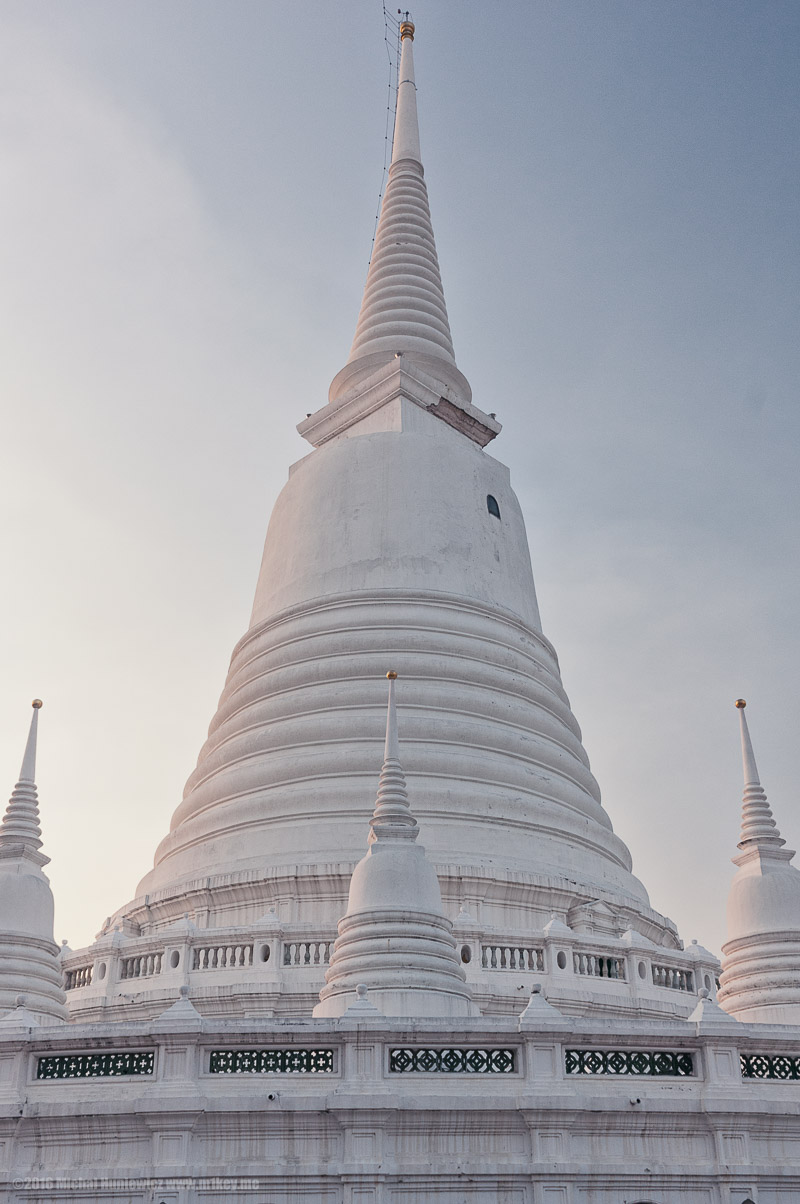
That was the inside of a stupa. These structures originated in India, spread across Asia, evolving into pagodas or chörtens. They have various purposes, but all contain a treasury... Interesting, I will remember that next time I visit one... Different parts of it have a different symbolic meaning, but there's always practical considerations: the stupa is fairly earthquake-proof. [9]
ISO 200, 24mm, f/6.3, 1/125s.
Stupas
Not Tattoo
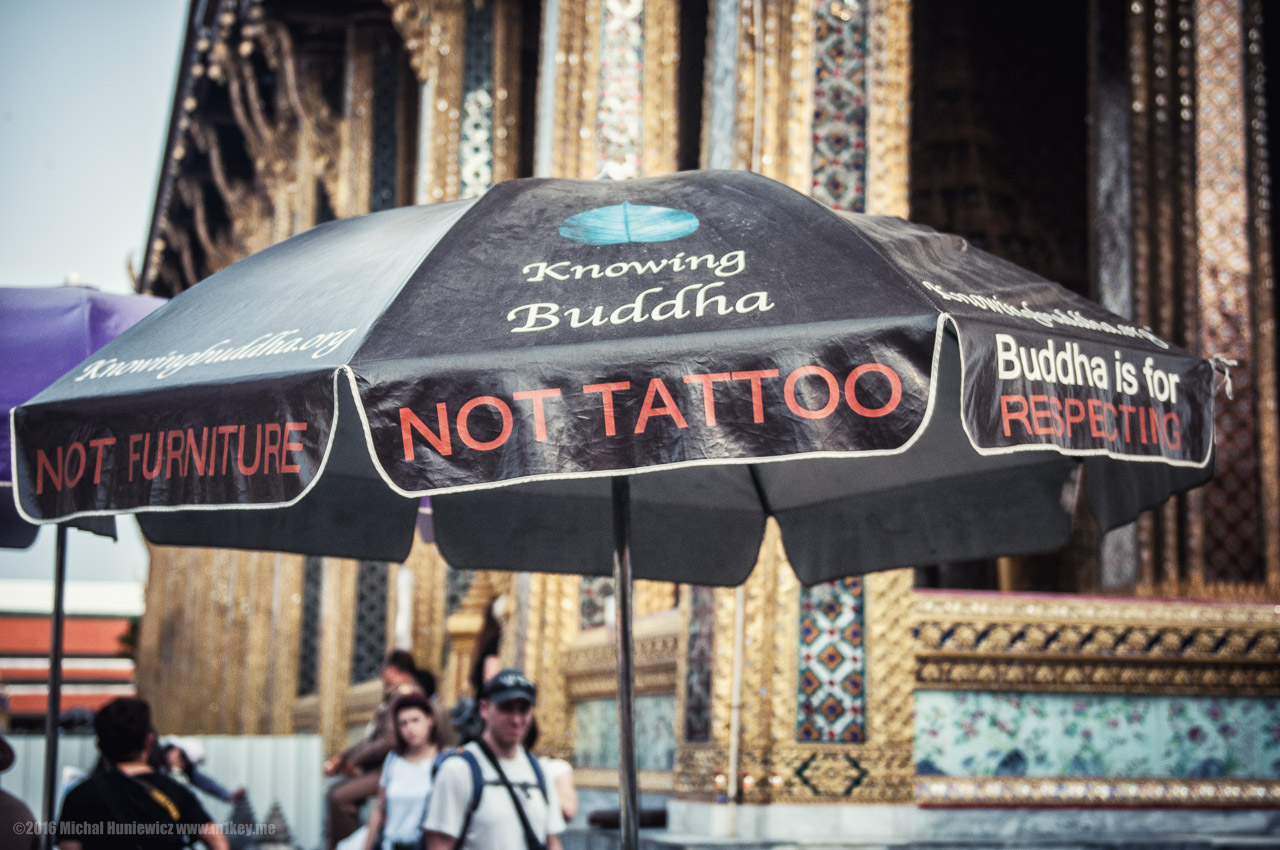
Buying Buddha statues and other Buddha-related items, and trying to get them across the border can get you into trouble in Thailand, as well as having a Buddha tattoo. Despite these restrictions and demands of respect, Buddha statues ranging from tiny to enormous are being sold everywhere in Thailand.
ISO 200, 36mm, f/2.8, 1/1000s.
Ksenia in a Temple
Gold
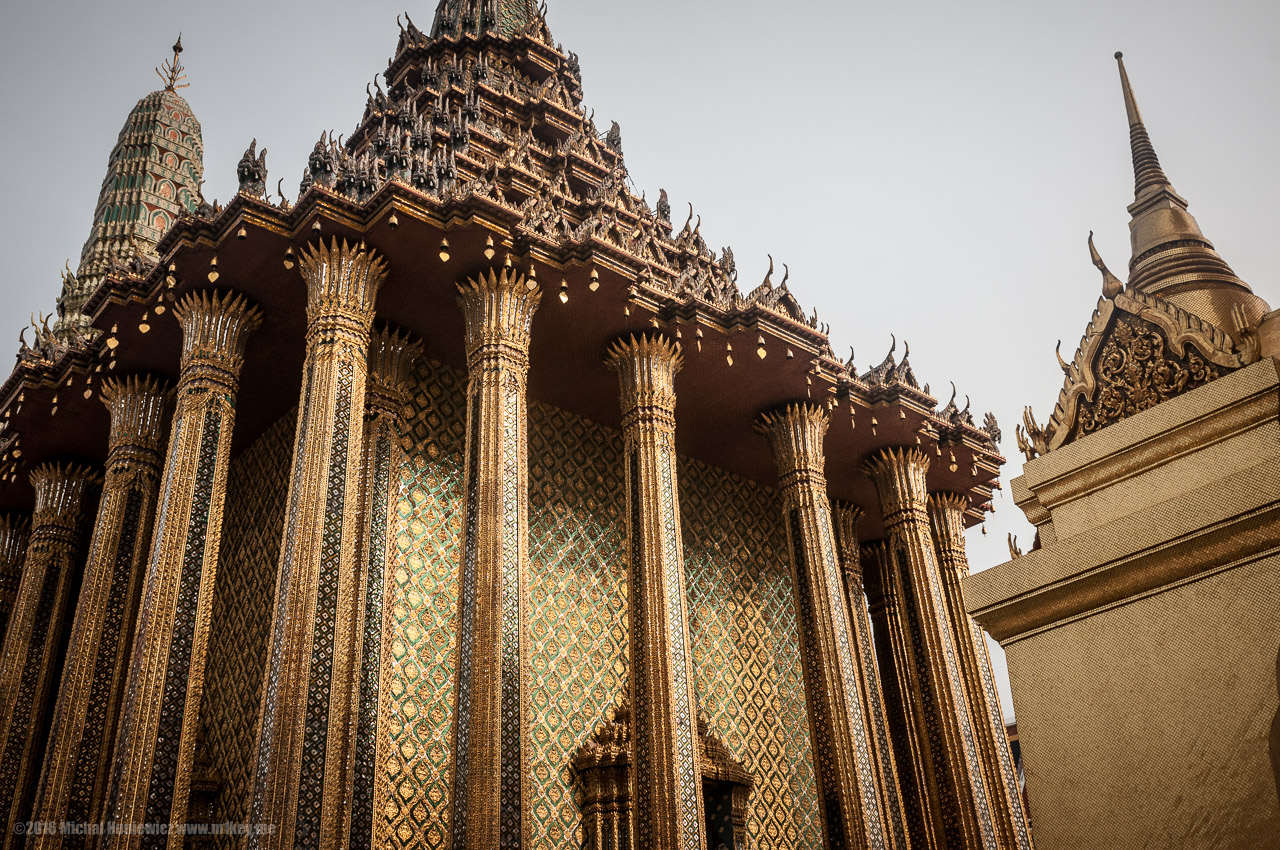
A Buddhist I met in Poland referred to this kind of Buddhism as Catholic.
ISO 200, 24mm, f/7.1, 1/400s.
Long Ears
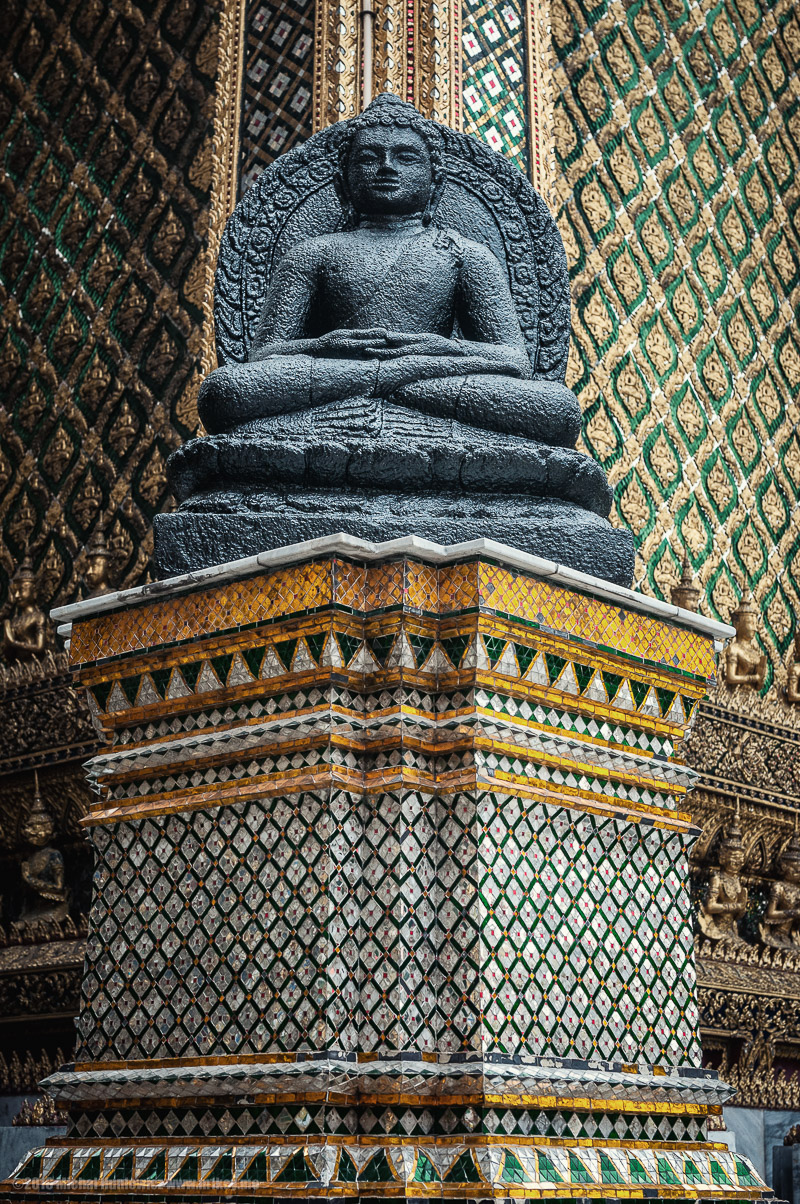
Buddha is often portrayed with long ears, as he was wearing heavy jewellery before he set out on a more meaningful journey and became who we see him as today.
ISO 200, 38mm, f/6.3, 1/100s.
At the Door
Decoration
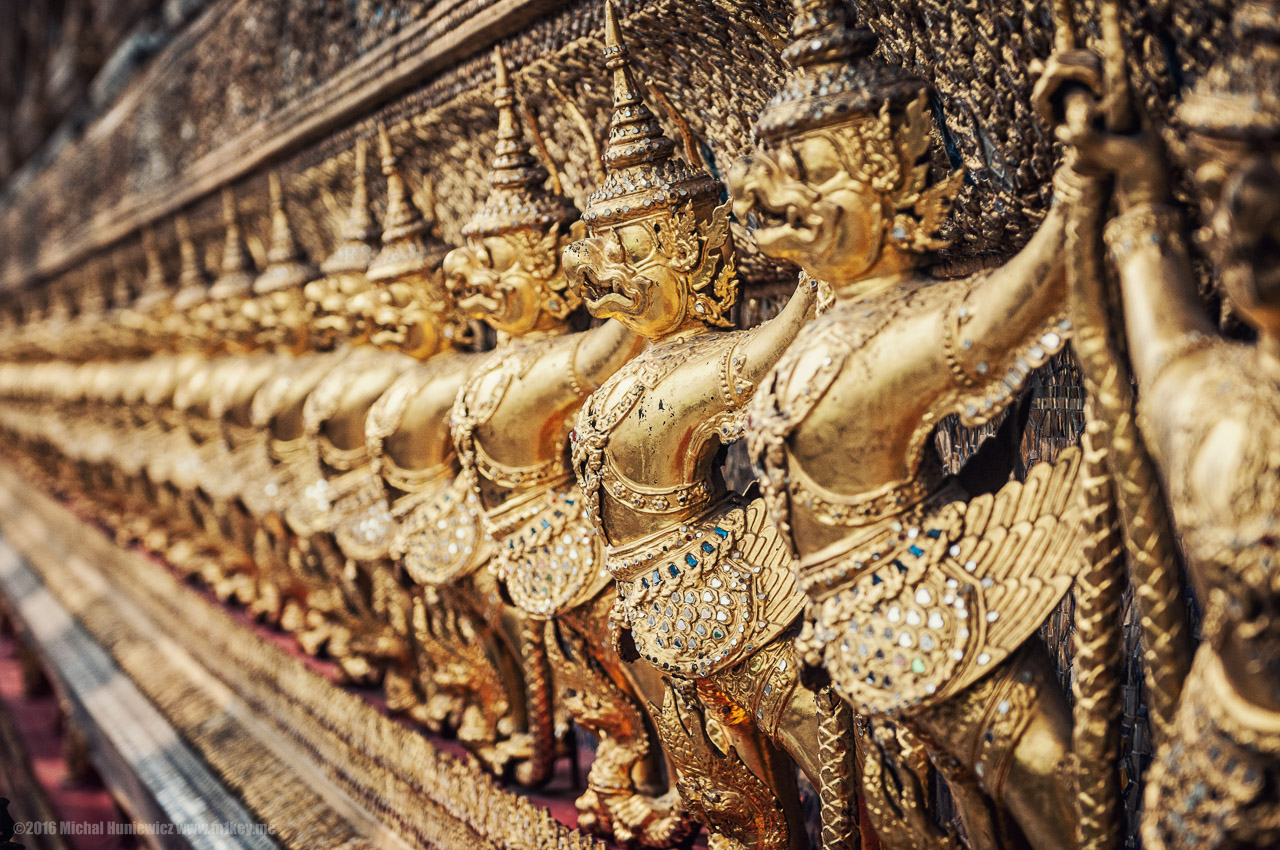
Temple outer decoration.
Thai people originate from Southern Chinese provinces, were refered to using the exonym Siamese, and soon most of them came under Khmer rule. [15] Khmers can be thought of as proto-Cambodians.
Thai people originate from Southern Chinese provinces, were refered to using the exonym Siamese, and soon most of them came under Khmer rule. [15] Khmers can be thought of as proto-Cambodians.
ISO 200, 70mm, f/3.5, 1/250s.
Guard
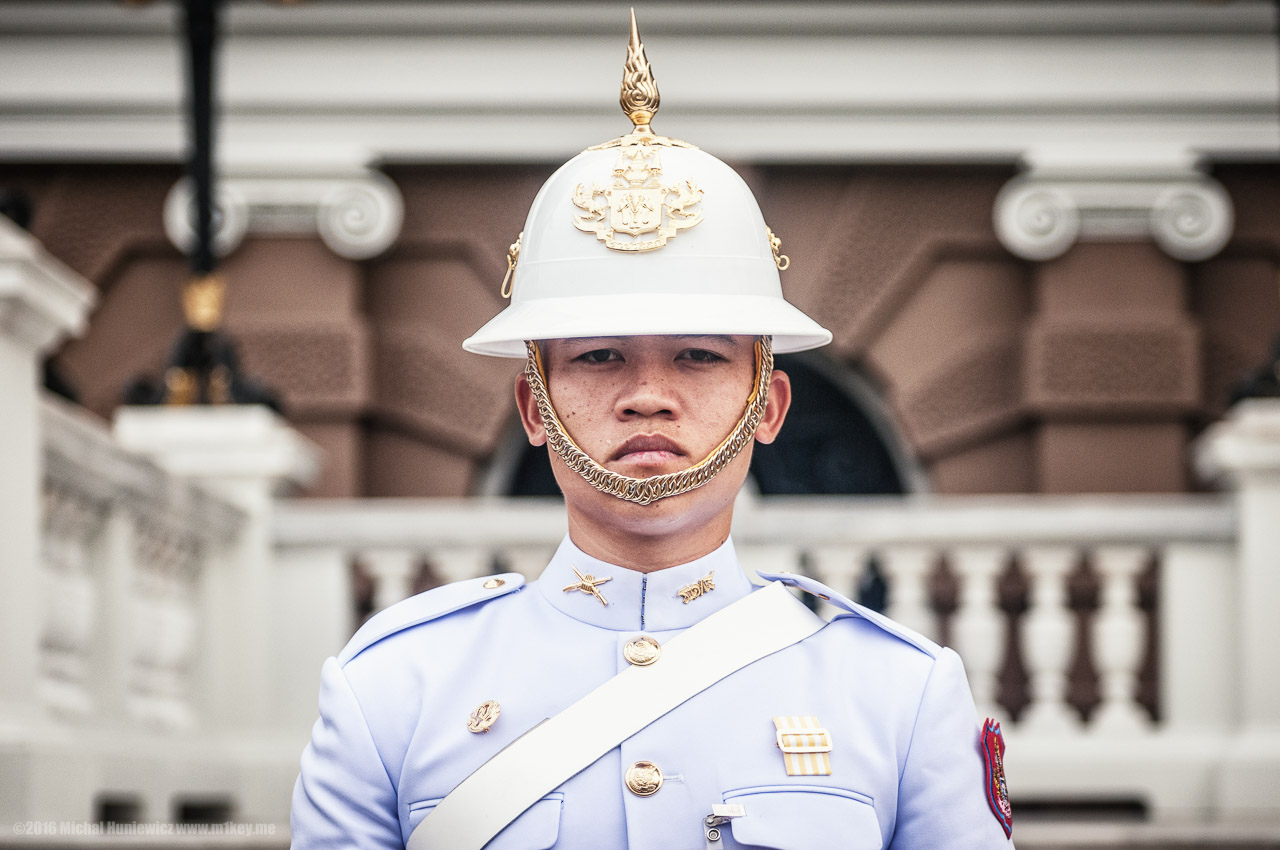
But ethnic Thais overpowered Khmer rulers, and established the independent Kingdom of Sukhothai in 1238. [2]
ISO 200, 62mm, f/2.8, 1/500s.
Dragons
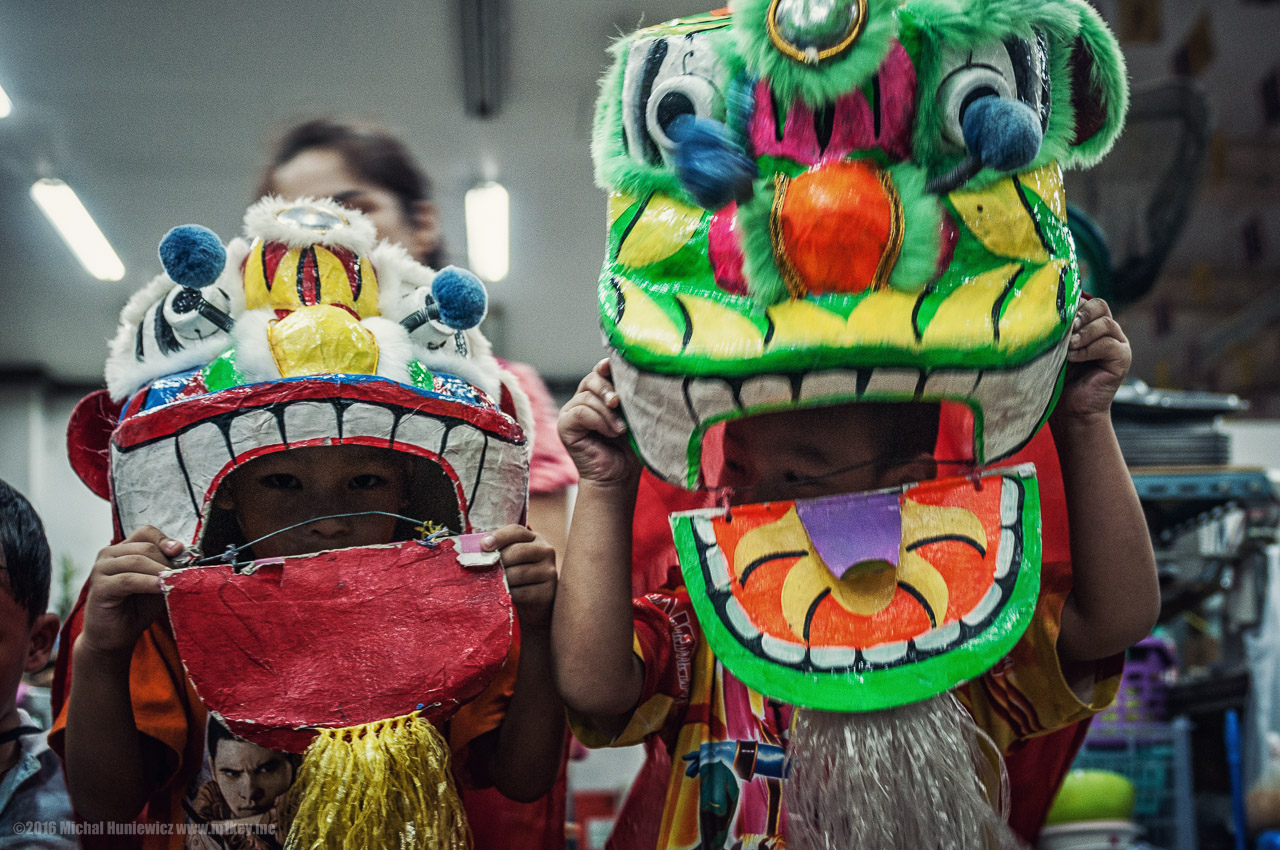
Various Thai kingdoms appeared and disappeared, sometimes fighting against one another. Generally speaking, the Sukhothai Kingdom was followed by that of Ayutthaya, Thonburi, and Rattanakosin. The Kingdom of Rattanakosin is also referred to as the Kingdom of Siam, and it was ruled by successive kings as an absolute monarchy until a military coup in 1932 - it became a constitutional monarchy then. [2] [17]
Children wearing a Chinese dragon costume. They just wouldn't stand still.
Children wearing a Chinese dragon costume. They just wouldn't stand still.
ISO 280, 24mm, f/2.8, 1/40s.
Flags

Like in Britain 150 years ago [10], in Thailand criticising the monarchy isn't exactly safe and can bring legal trouble. From the safety of my home I will complain that the thickest, central stripe of the Thai flag - the blue stripe - signifies monarchy (I'm a republican when it comes to monarchy). Red is for land and people, white for religions. [11]
ISO 200, 70mm, f/2.8, 1/80s.
Angkor Wat

On that note, we're off to Cambodia! Someone pleasantly surprised me saying this photo reminded them of the work of Caspar David Friedrich.
ISO 200, 70mm, f/2.8, 1/2000s.
Not So Romantic Now
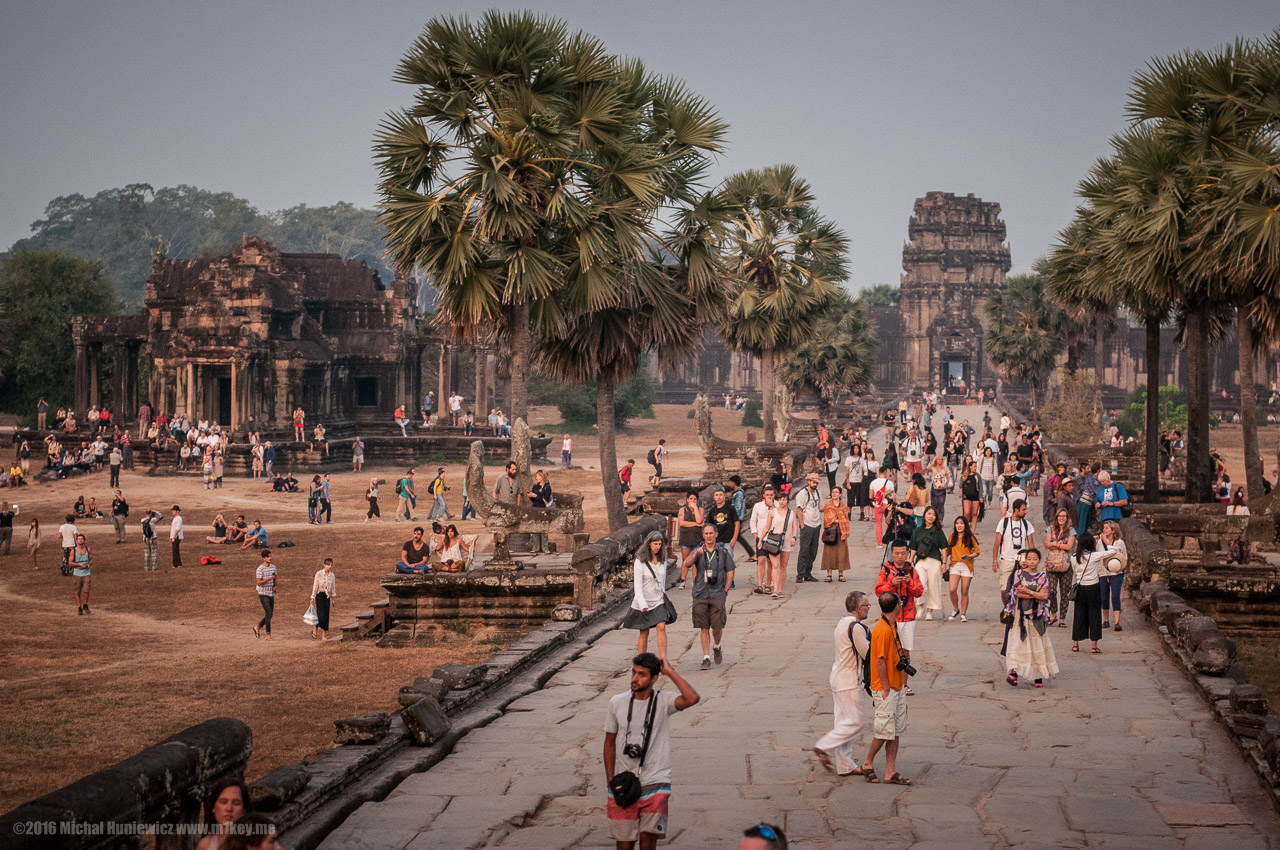
Even before sunrise, Angkor Wat is massively crowded.
ISO 640, 70mm, f/2.8, 1/50s.
In a Temple
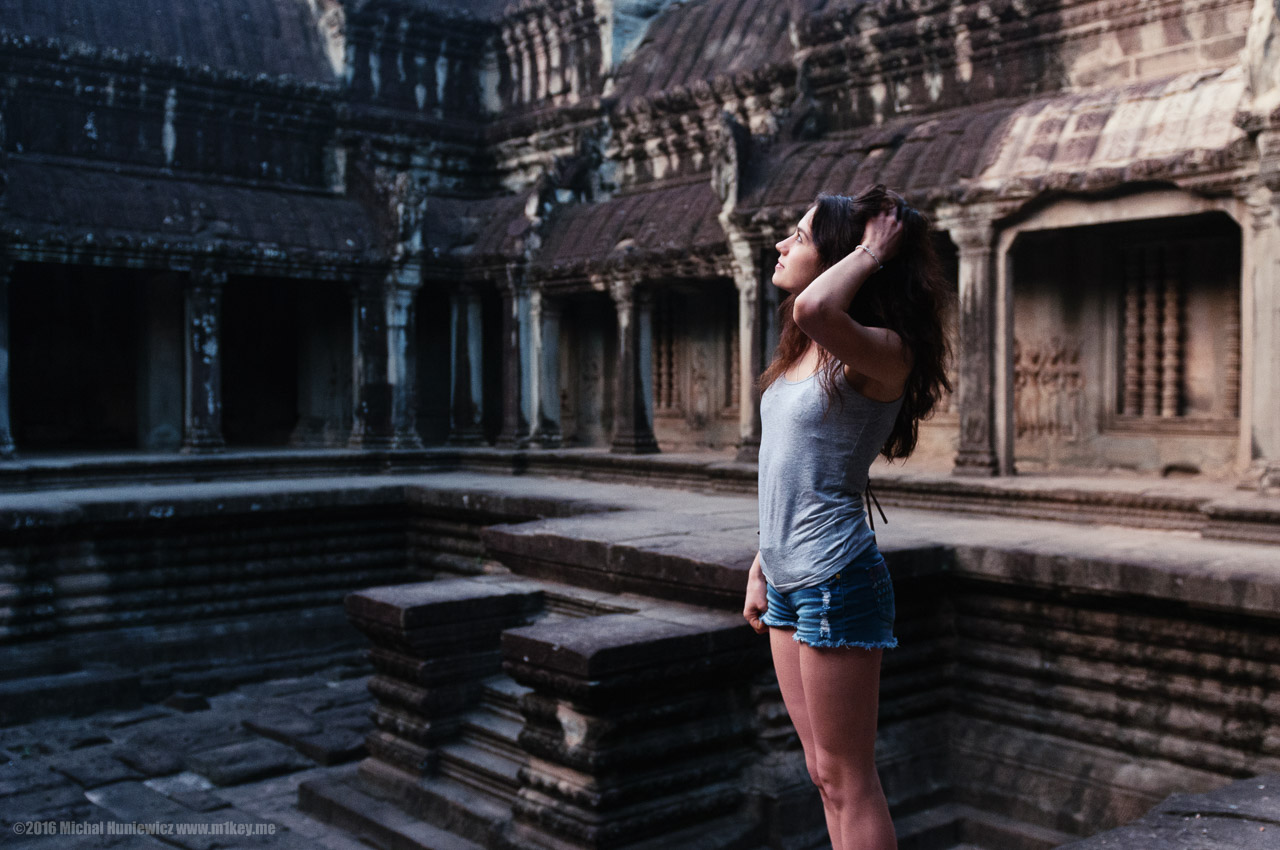
"The temples of Ancient Angkor - the largest ruins in the world and the only archaeological site visible from outer space - are just the stone heart of a city that has long since rotted away" -- John Tully. [2]
ISO 400, 24mm, f/2.8, 1/50s.
Devatas or Apsaras?
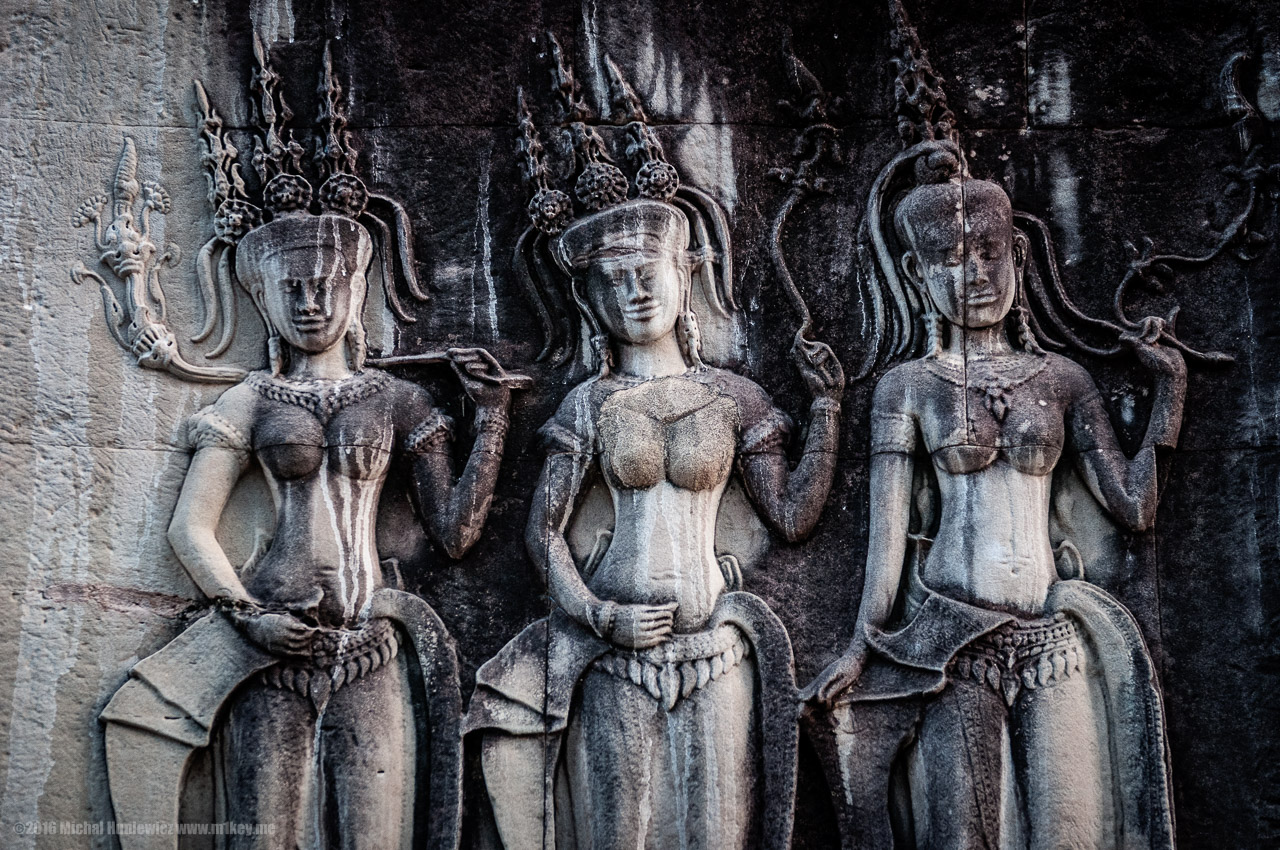
Wikipedia tells us that "in harmony with the Indian association of dance with apsaras, Khmer female figures that are dancing or are poised to dance are considered apsaras; female figures, depicted individually or in groups, who are standing still and facing forward in the manner of temple guardians or custodians are called devatas." [12] Are these dancing?
ISO 400, 45mm, f/2.8, 1/60s.
Cold Palm Juice
Tree
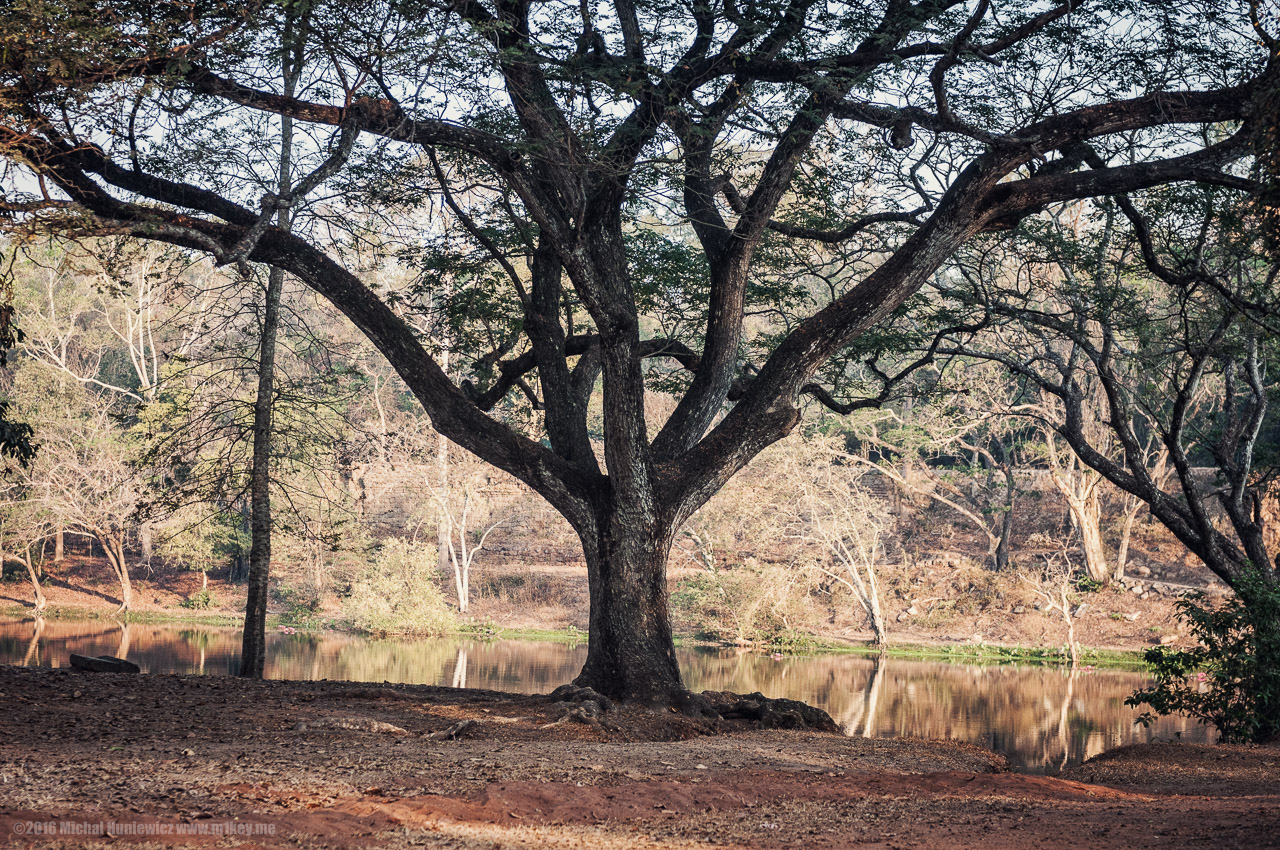
As we know, the Khmers dominated over the Thais at first, but then the roles began to reverse. In fact, the more recent centuries of the Cambodian history is being squeezed between Thailand and Vietnam. The book on Cambodia I read is aptly titled "from Empire to Survival".
The Siem Reap River was the Khmer version of the sacred Ganges, while the Angkor temple itself is meant to represent Mount Meru - all Indian influence. [14]
The Siem Reap River was the Khmer version of the sacred Ganges, while the Angkor temple itself is meant to represent Mount Meru - all Indian influence. [14]
ISO 200, 55mm, f/2.8, 1/250s.
Corbel Arch
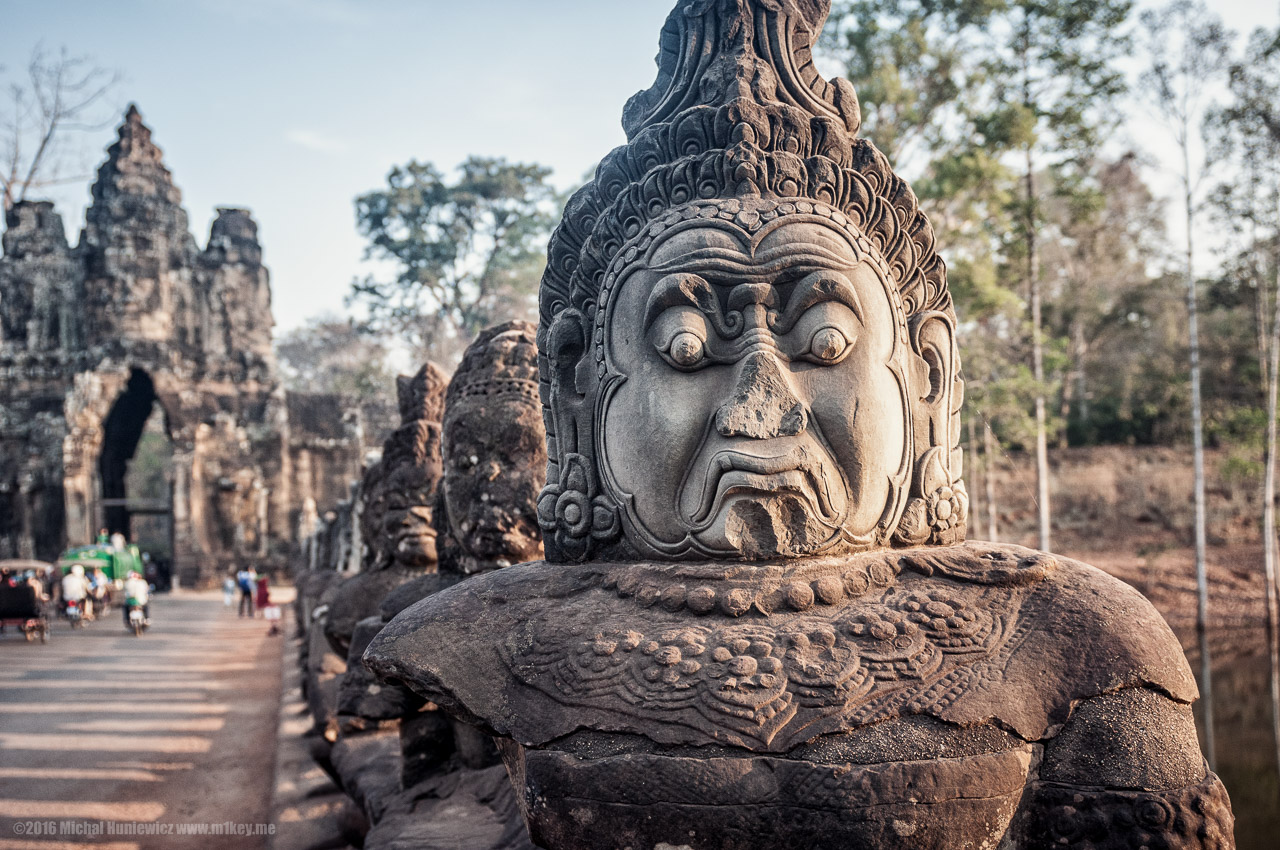
Just like the Mayans and Aztecs in Mesoamerica or ancient Egyptians, the inhabitants of ancient Cambodia (the Khmer Empire) never invented the keystone, that makes creating arches possible. Instead, they constructed fake arches known as corbel arches, which are inferior as far as load-bearing ability goes.
ISO 200, 24mm, f/2.8, 1/320s.
Bayon
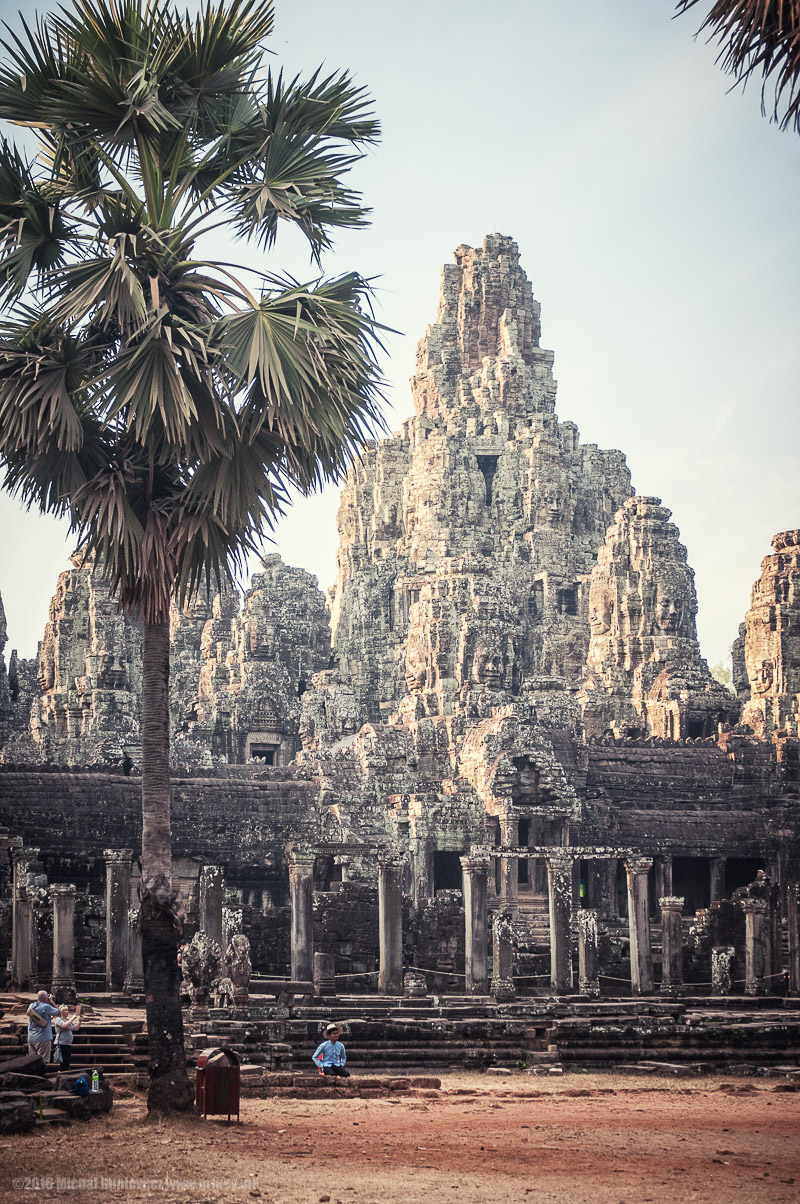
The serene, smiling faces of the Bayon temple. The temple is meant to be "the most striking expression of the baroque style" of Khmer architecture, as contrasted with the classical style of Angkor Wat. [13]
ISO 200, 45mm, f/2.8, 1/400s.
Faces
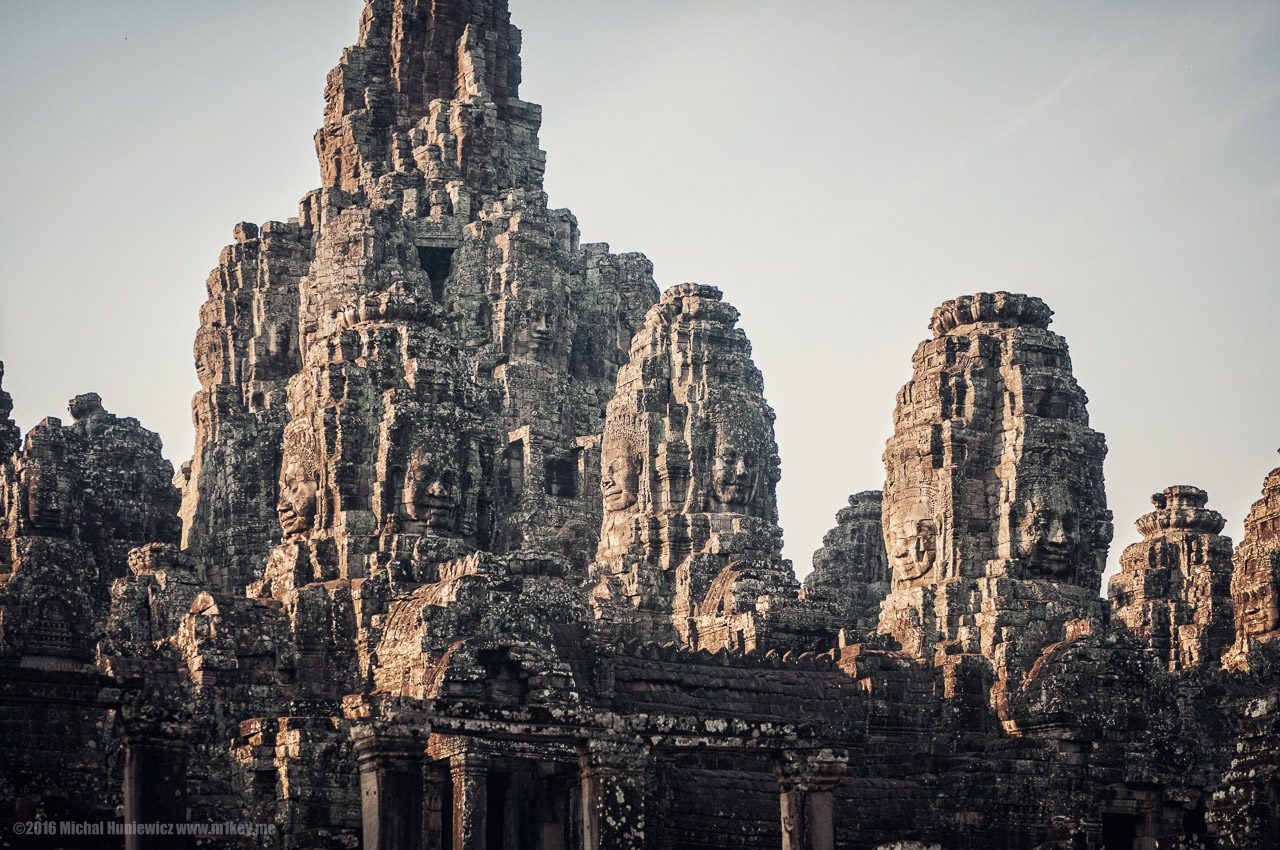
There was no unitary Cambodian state until the foundation of Angkor in the beginning of the 9th century AD. [14]
ISO 200, 48mm, f/2.8, 1/800s.
Ksenia at Bayon
Temple Buddha
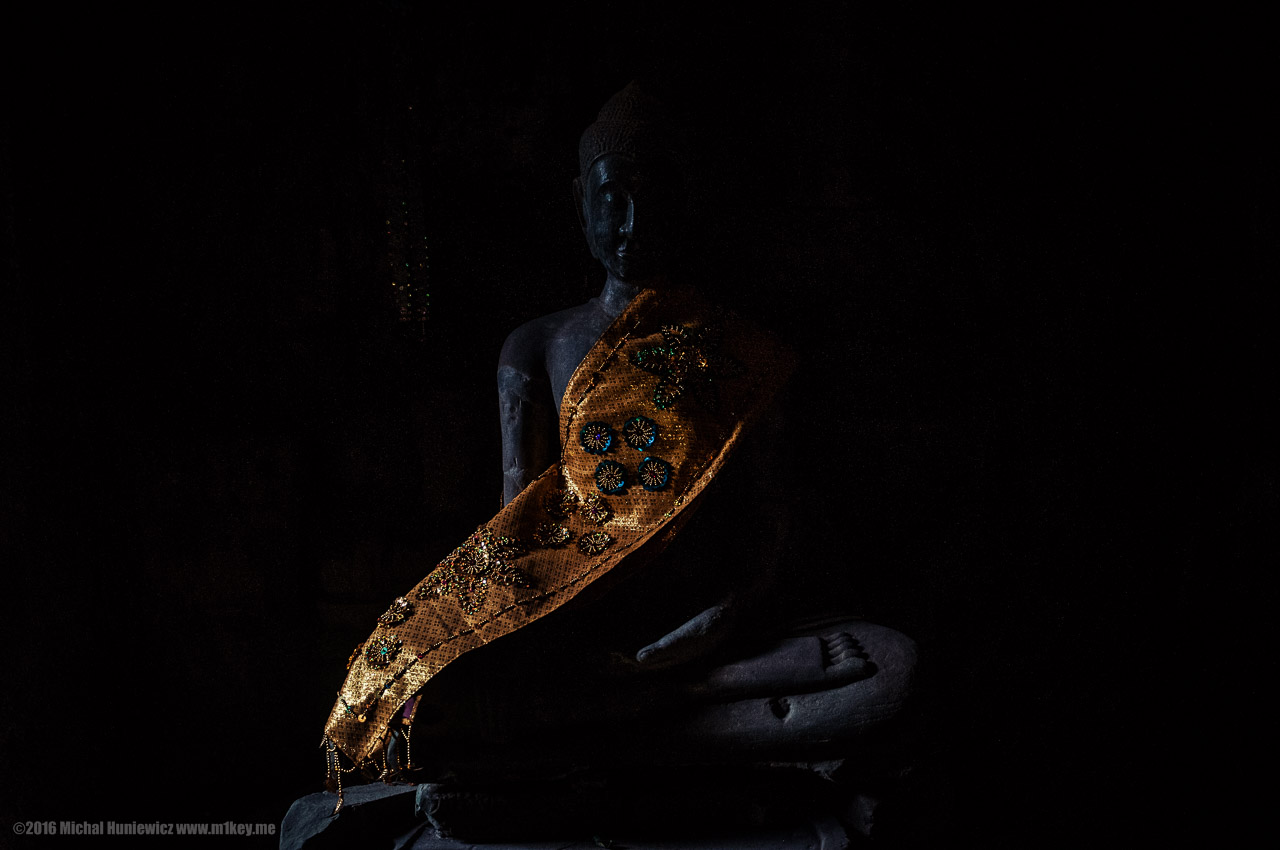
Some Europeans initially believed that the city was of Indian, Roman, or even Italian origin. [14] Nice. The European who rediscovered Angkor Wat, Henri Mouhot, was meant to come across the complex as he was chasing butterflies... [18] Don't believe everything you read.
ISO 400, 24mm, f/2.8, 1/40s.
Smile
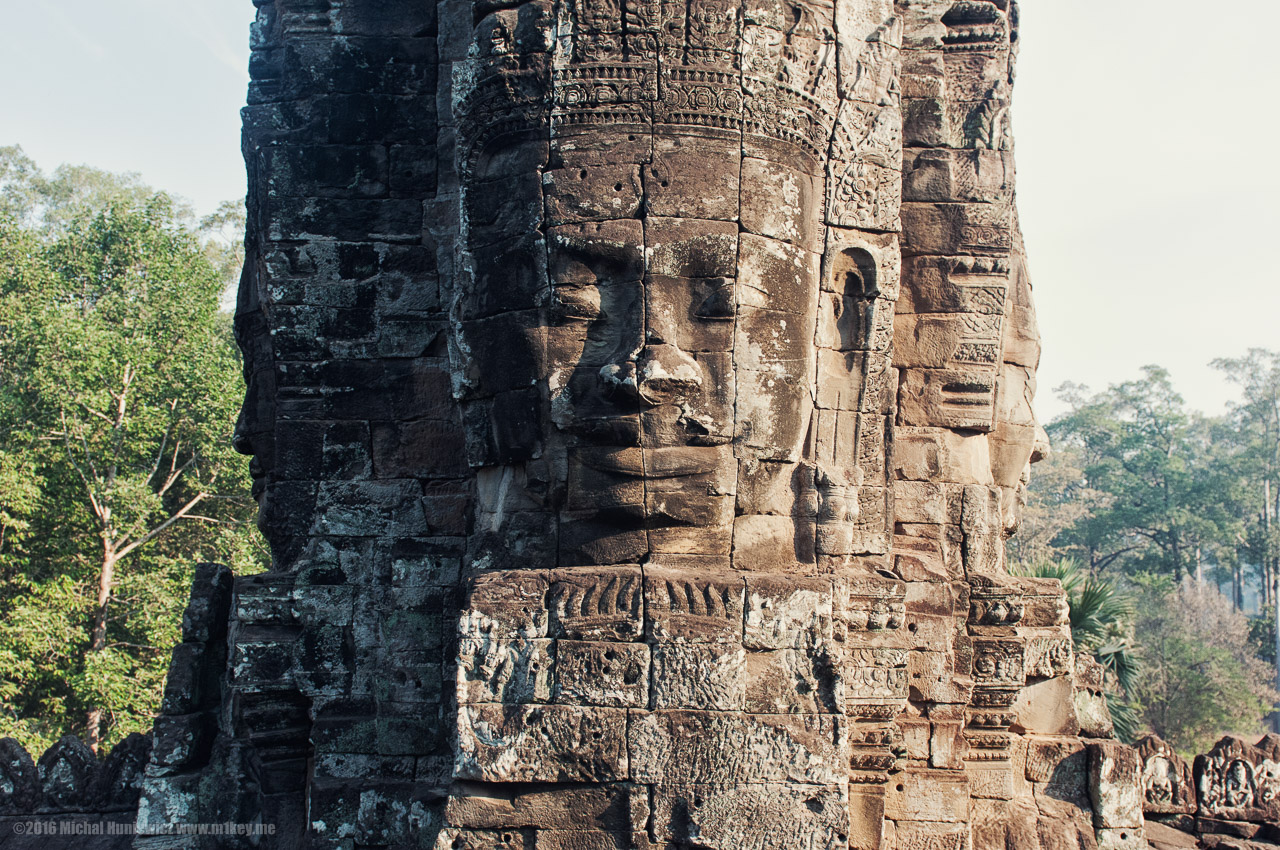
The problem with ancient Angkor is that the Khmers have left us no books, unlike other civilisations. It's not that they were not keen on reading or writing, as libraries do exist. The books apparently all rotted away in the wet climate after the city was abandoned. [19]
ISO 200, 24mm, f/3.5, 1/500s.
A Breathing Apsara
Hidden Face
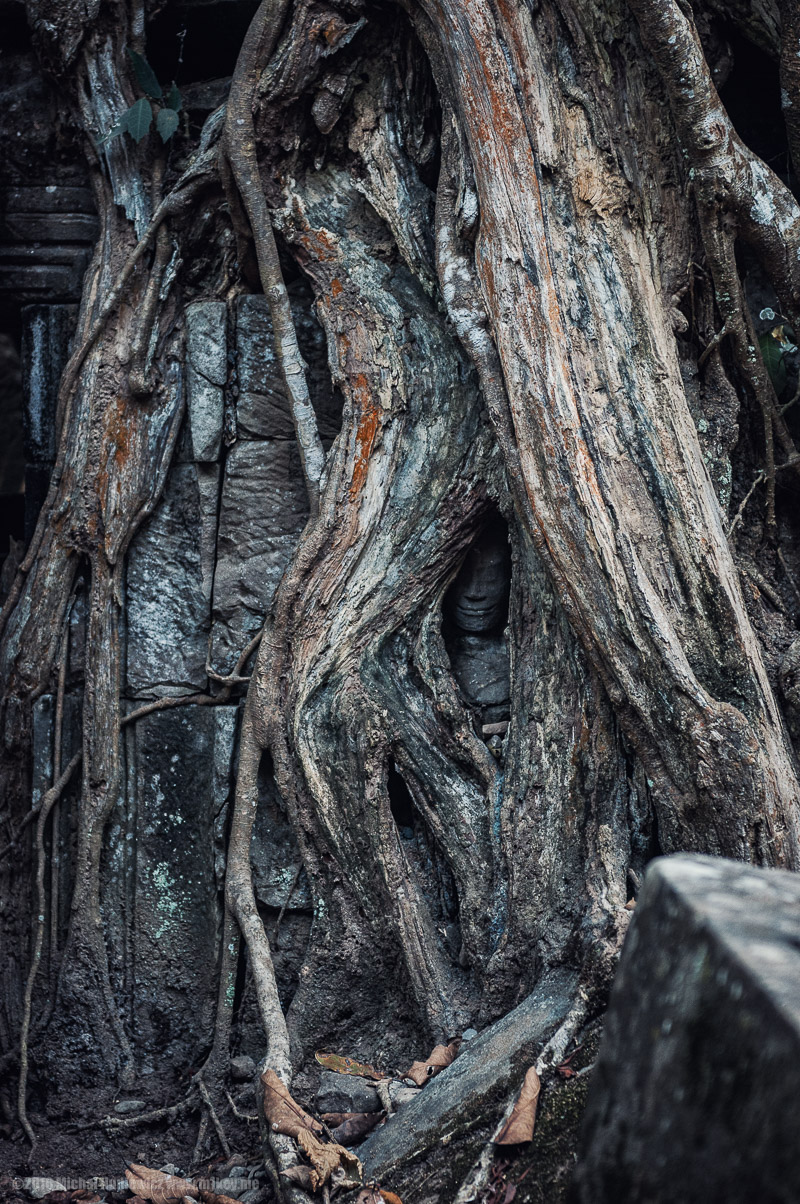
We spent quite a while searching for the Buddha face partially covered by the roots, after my OCD kicked in. We only found this one, as the roots are being gradually removed these days. This wasn't the one! Finally, a more competent guide told me "you're in the wrong country!" The head I was looking for was elsewhere.
ISO 200, 70mm, f/2.8, 1/100s.
Guardian Spider
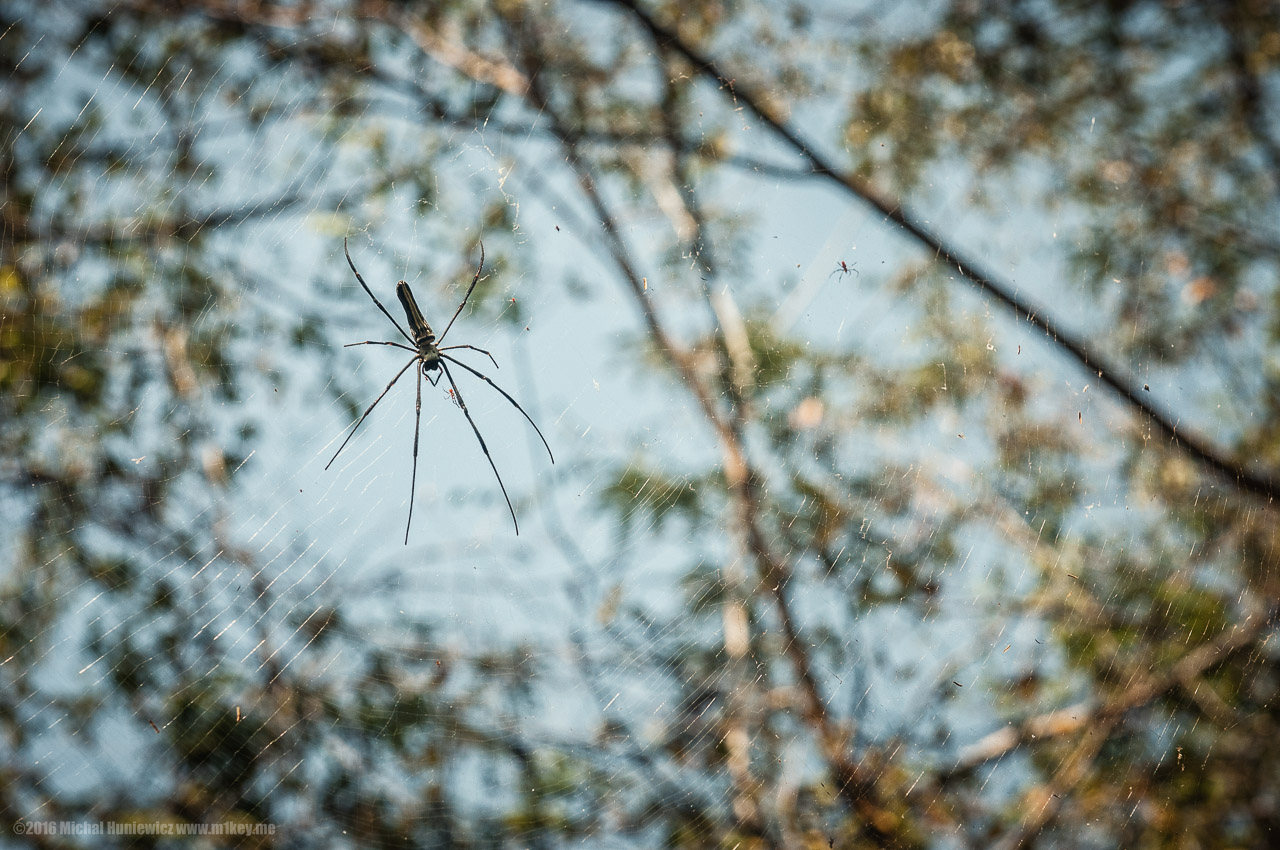
Spider guarding a rarely visited temple ruin. As big as your hand, and I almost walked into it, absolutely horrifying.
ISO 200, 70mm, f/8.0, 1/160s.
In the Jungle
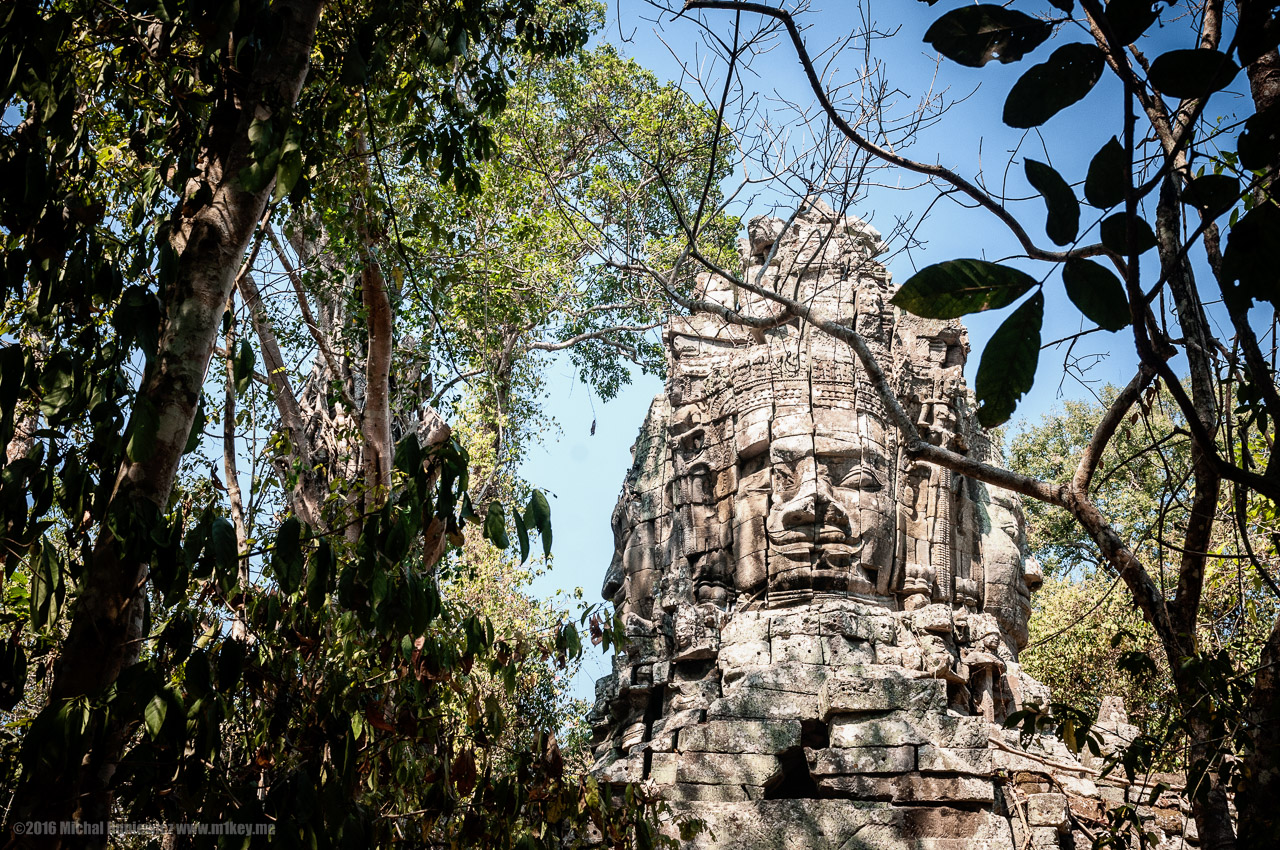
But we found this, and there were no tourists in the area.
ISO 200, 27mm, f/8.0, 1/80s.
Ouch
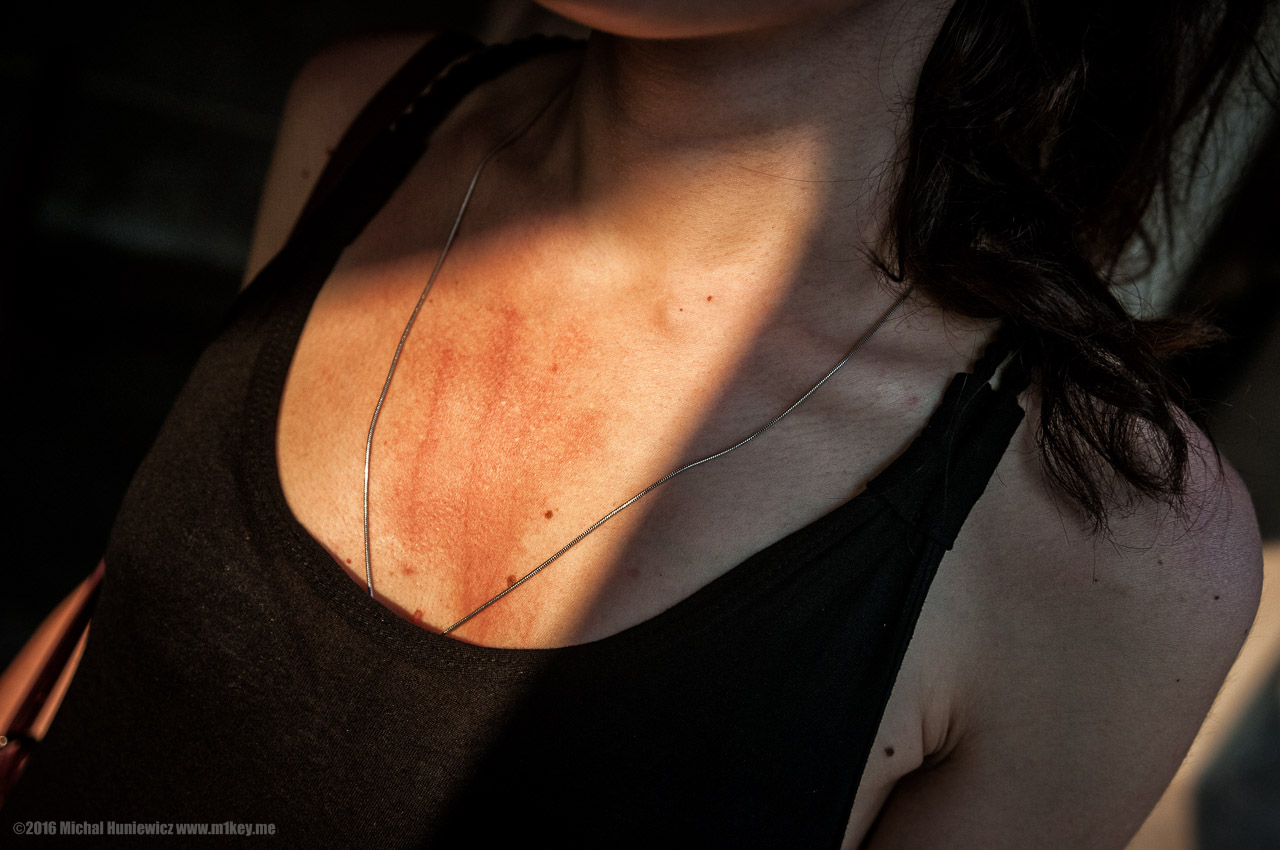
Ksenia isn't always able to make the best decisions. She had a close encounter with a monkey.
ISO 200, 24mm, f/2.8, 1/800s.
Kompong Phluk Village

The fishermen's village of Kompong Phluk. Built on stilts in anticipation of the wet season.
ISO 200, 24mm, f/7.1, 1/160s.
Smoking Monks
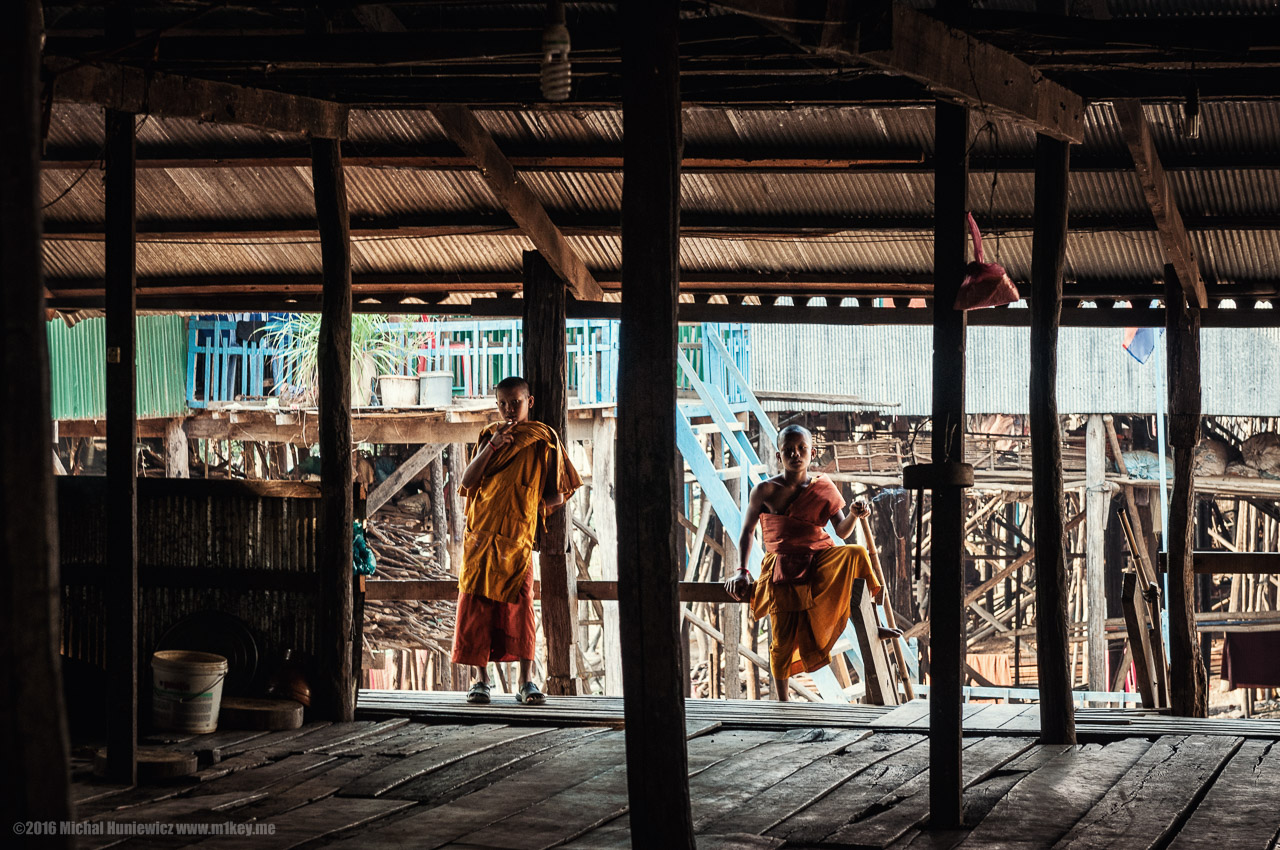
Everyone going to Cambodia is hoping for a nice photo of Buddhist monks in a temple setting - me, I got a photo of two rather young monks smoking...
ISO 200, 62mm, f/5.6, 1/40s.
Girl Smelling Flowers

Shocking statistic: 70% of children from the Angkor Wat area had sexual offers from Westerners. [14]
ISO 200, 60mm, f/2.8, 1/1000s.
Ksenia in a Boat

It was almost hellishly hot in Cambodia, so it was quite refreshing to take the boat ride. Well, we associate hell with fire and heat, but the Khmers believed that hell was a place of eternal, bone-chilling cold. I wouldn't mind.
ISO 200, 24mm, f/2.8, 1/250s.
Bebito
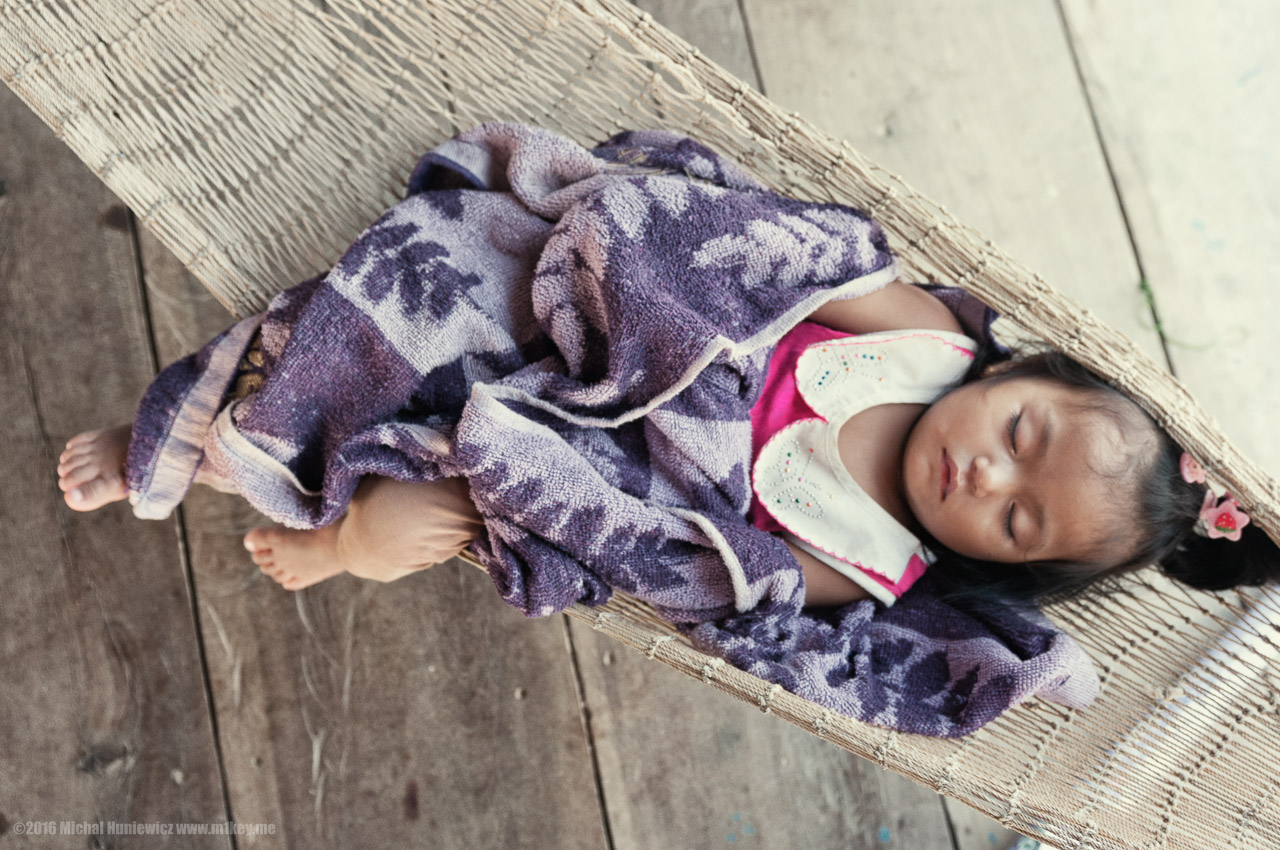
Baby we found floating in a barge. Bring your baby to Thailand, and people will tell you it's ugly. That is one ugly baby you brought here! - they will possibly say. They're not trying to be rude though (or honest), they're trying to merely distract the spirits and discourage them from harassing your baby.
ISO 200, 24mm, f/2.8, 1/160s.
Going Back
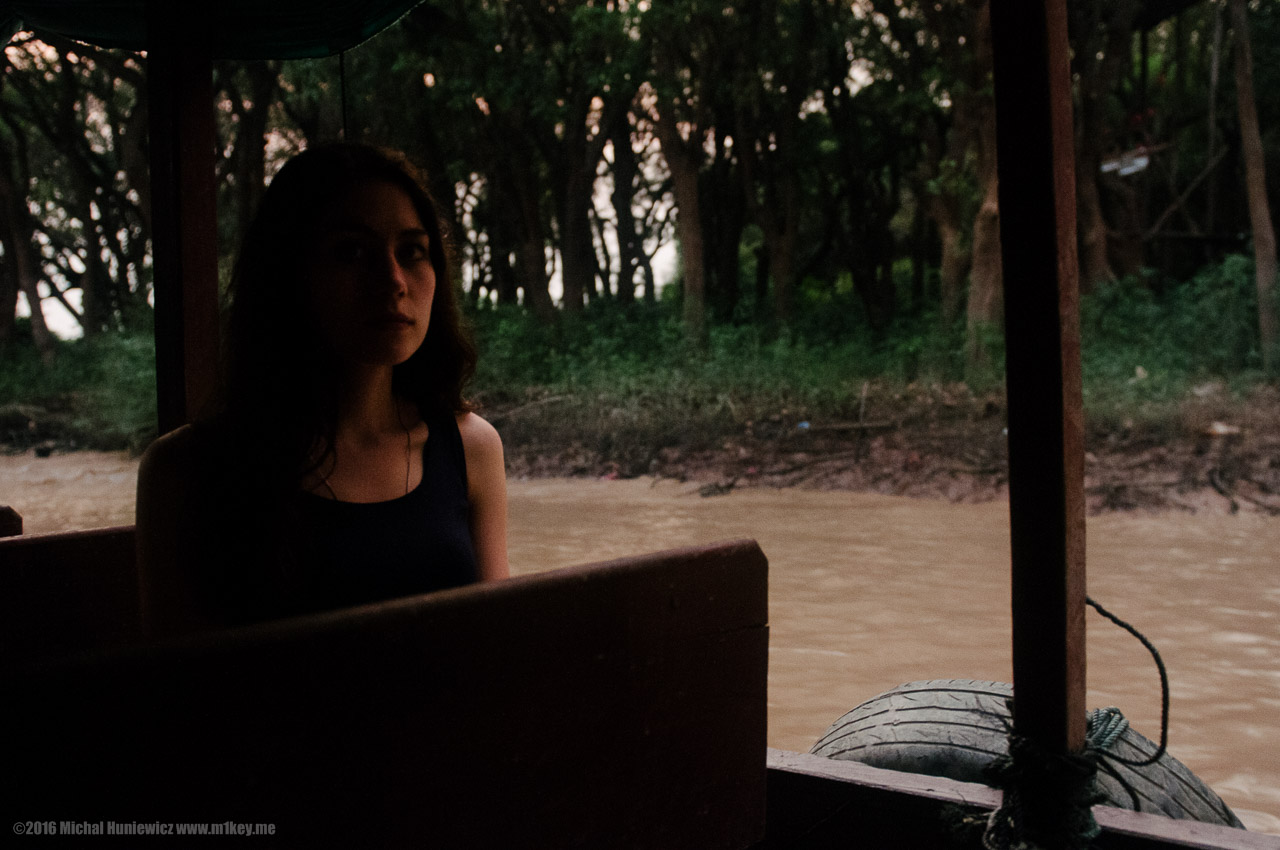
We returned to the village in the evening, as shown by high ISO.
ISO 800, 24mm, f/2.8, 1/20s.
Amina
Death
This Is How Silk Is Made
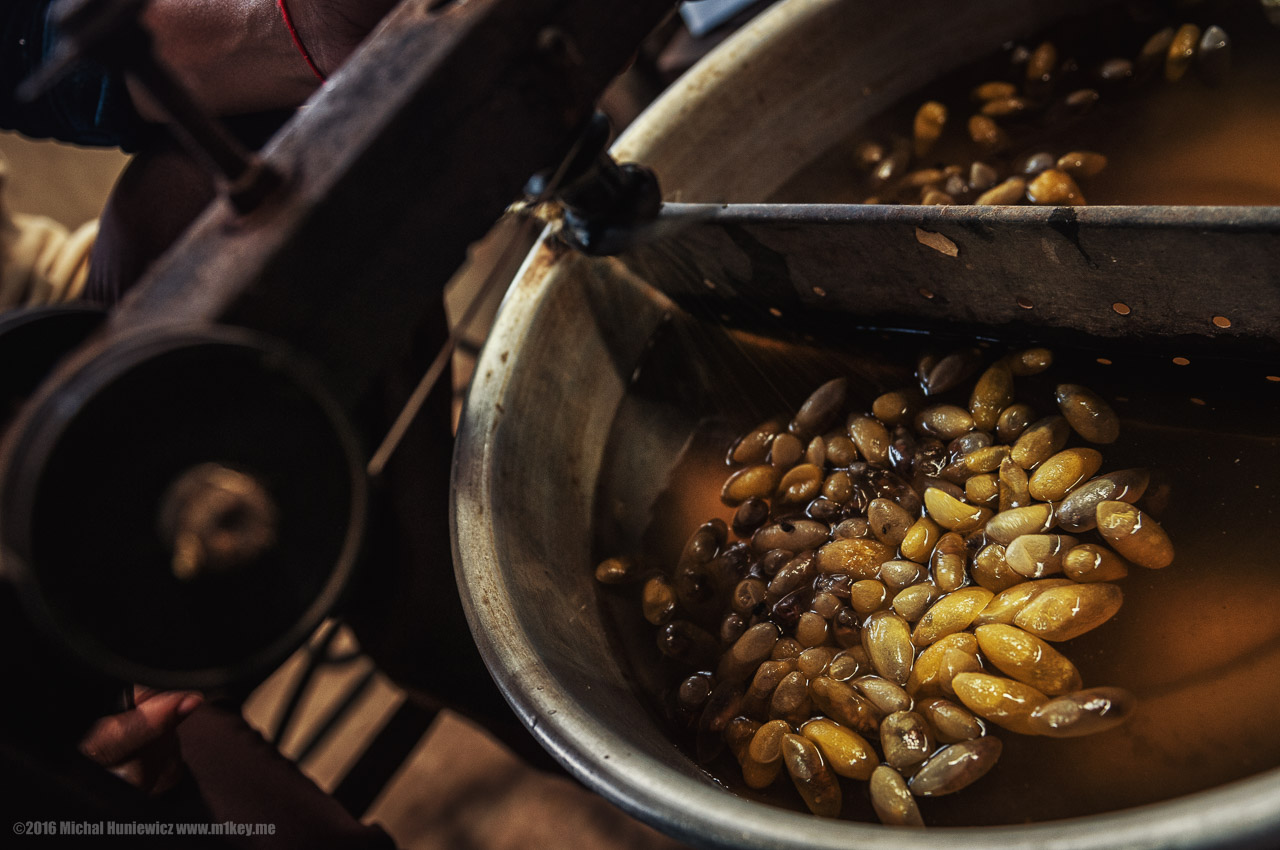
This is how silk is made.
Turns out that while the Chinese used human manure as fertiliser, the Khmers found it abhorrent. [14] I most likely ate human manure-produced food in North Korea, where they still use it to this day, as South Korea won't sell them other fertilisers.
Also, you might have heard that the reason pork is forbidden in Judaism and Islam is because hot climate makes it difficult to store meat [20] - well, from inscriptions we know that the Khmers ate venison and pork... [14]
Turns out that while the Chinese used human manure as fertiliser, the Khmers found it abhorrent. [14] I most likely ate human manure-produced food in North Korea, where they still use it to this day, as South Korea won't sell them other fertilisers.
Also, you might have heard that the reason pork is forbidden in Judaism and Islam is because hot climate makes it difficult to store meat [20] - well, from inscriptions we know that the Khmers ate venison and pork... [14]
ISO 200, 24mm, f/2.8, 1/60s.
Cocoon Dress
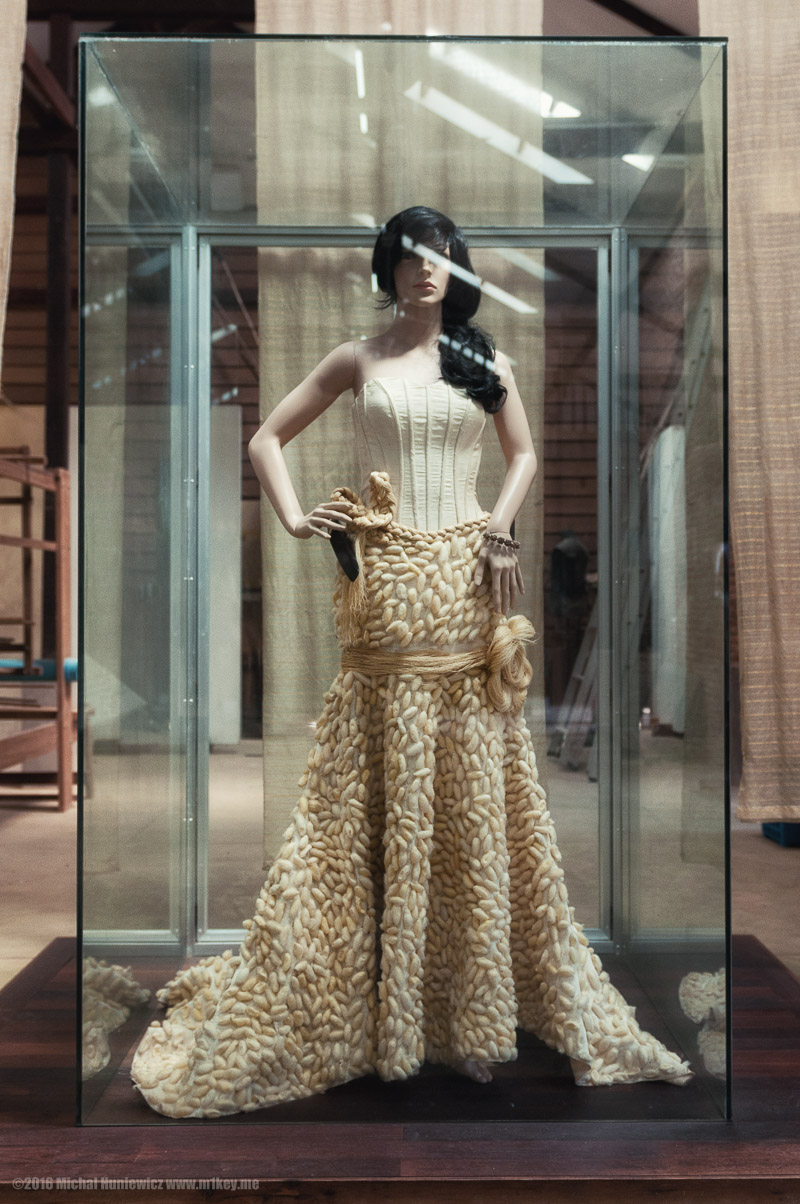
Silk worm cocoon dress.
An interesting fact about the Khmers is that they allowed a wife or husband to have another sexual partner if a partner was absent for more than ten nights. [14]
An interesting fact about the Khmers is that they allowed a wife or husband to have another sexual partner if a partner was absent for more than ten nights. [14]
ISO 200, 24mm, f/2.8, 1/160s.
Cheap Enough to Say Phuket, Let's Go
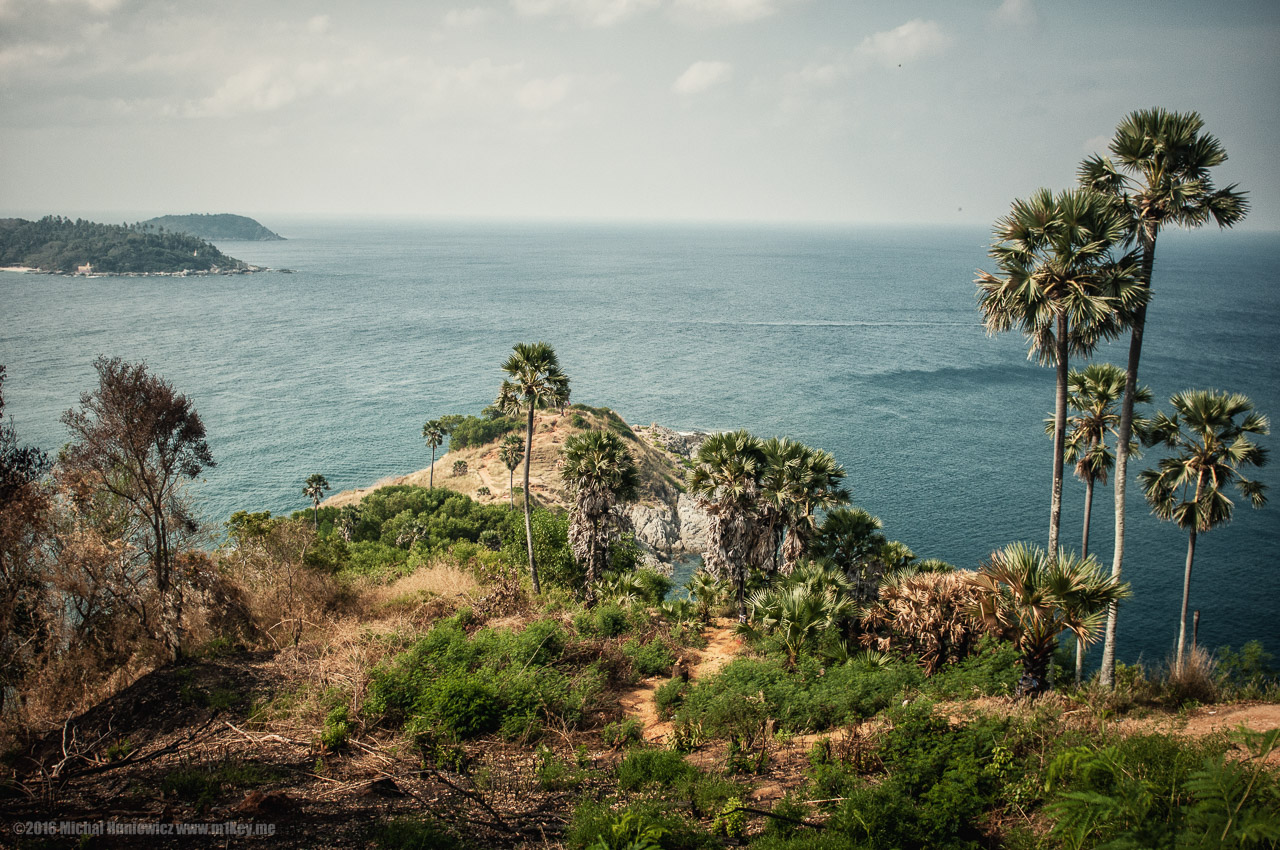
I love that Phuket ad: Cheap enough to say Phuket, let's go.
ISO 200, 24mm, f/2.8, 1/8000s.
Travellers' Guardian
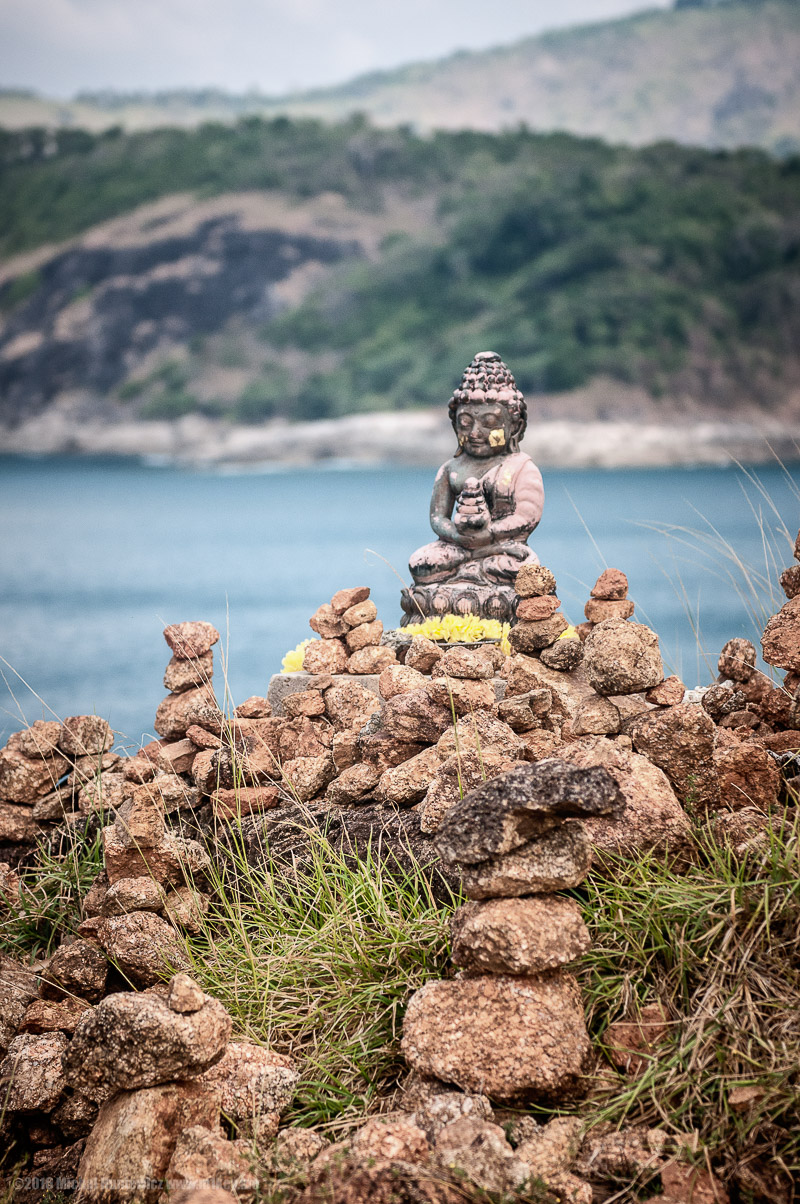
Wai is the Thai way of respectfully saying hello - slight bow, palms pressed together. It originates from the Indian namaste. [21] In Thailand, you'll even see figures of the McDonald's clown observing the wai. It's rude not to return it - but the highest classes of Thai people (the Royal family and monks) do not need to return a wai... "Men will never be free until the last king is strangled with the entrails of the last priest".
ISO 200, 70mm, f/2.8, 1/1250s.
Phi Phi

Moving on. Welcome to Phi Phi, top holiday destination in Thailand.
ISO 200, 24mm, f/8.0, 1/400s.
Monkey Beach
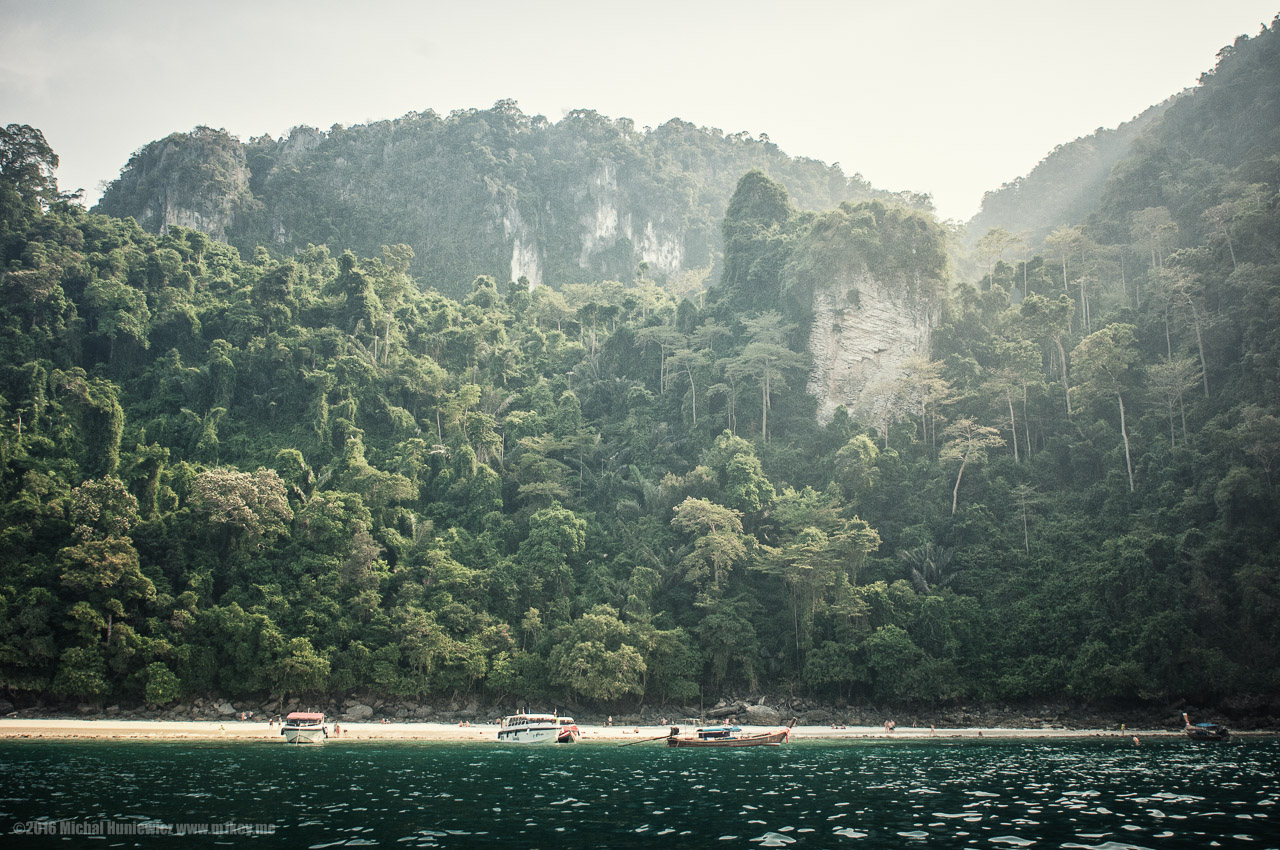
This beach is somewhat infamous in the sense that you may well get spanked by one of the monkeys that inhabit the impassable jungle beyond the narrow strip of sand. Supposedly, if you walk confidently in a monkey fashion, they may recognise you as their leader, but bear in mind you may have special obligations regarding the females.
ISO 200, 24mm, f/8.0, 1/125s.
In the Boat
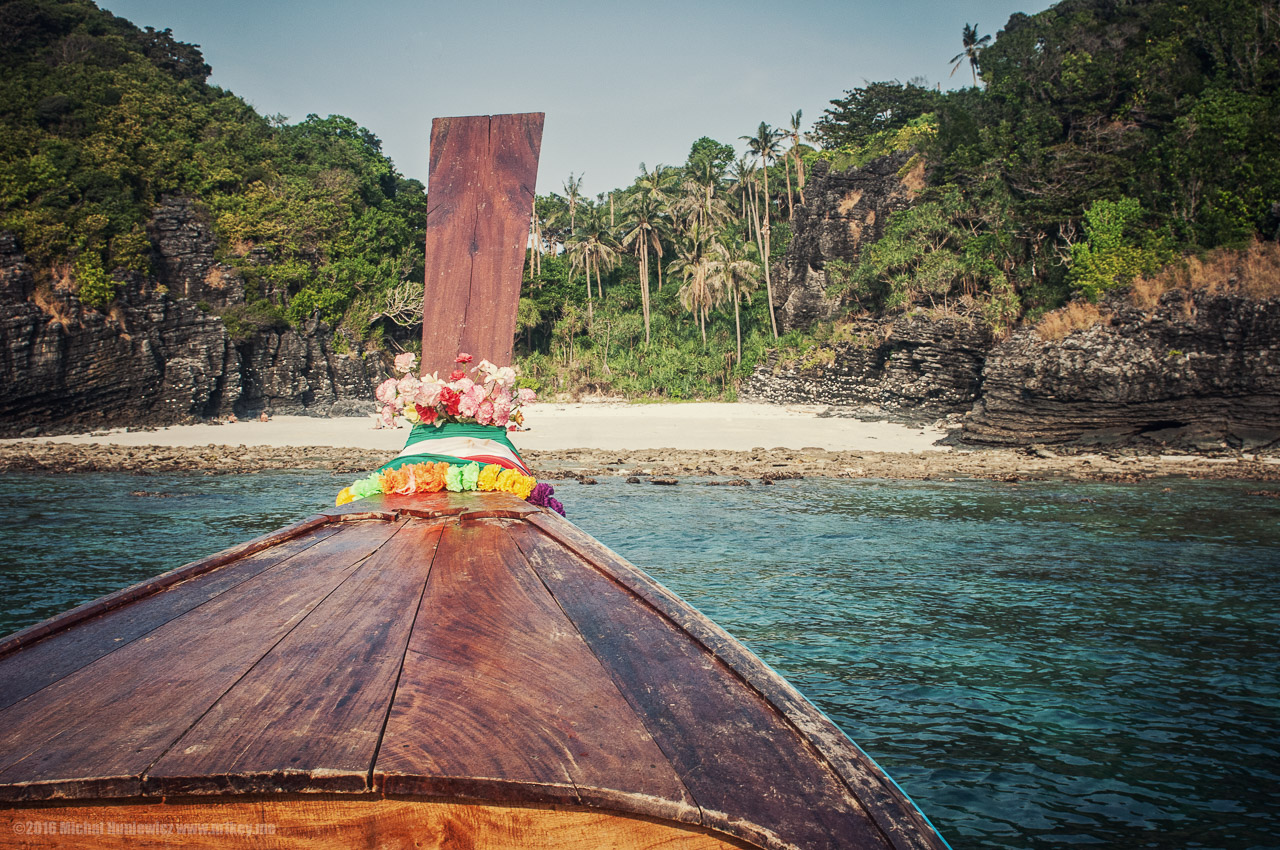
In the boat. The problem with Phi Phi beaches is that there are sharp rocks between the beach and the water, so they are likely to wreck your feet.
ISO 200, 24mm, f/8.0, 1/125s.
Train to Ayutthaya
Buddhist Monks
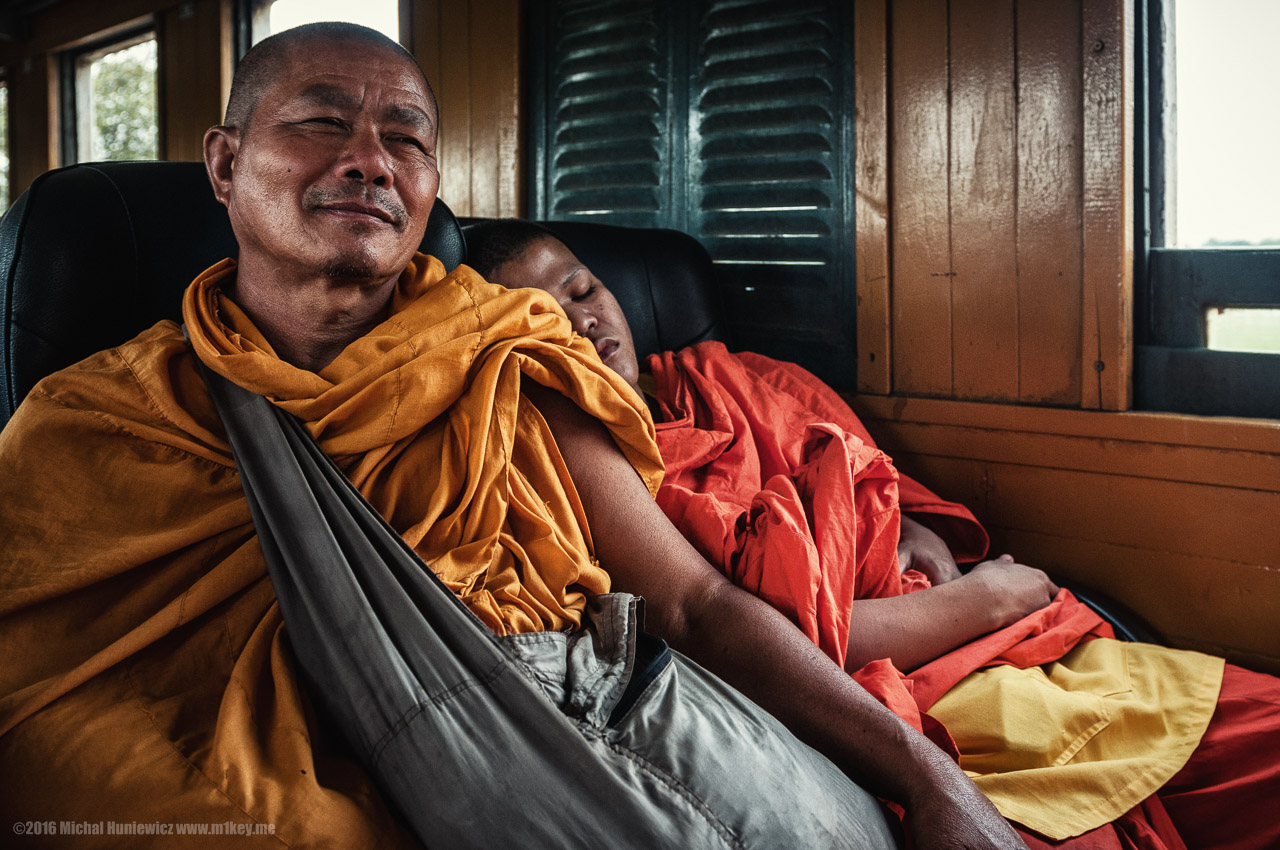
Buddhist monks in Thailand have specially allocated train seats. The man in the photo asked me about... the Prime Minister of Poland, Beata Szydło.
ISO 200, 24mm, f/4.0, 1/320s.
Rabbit Ears
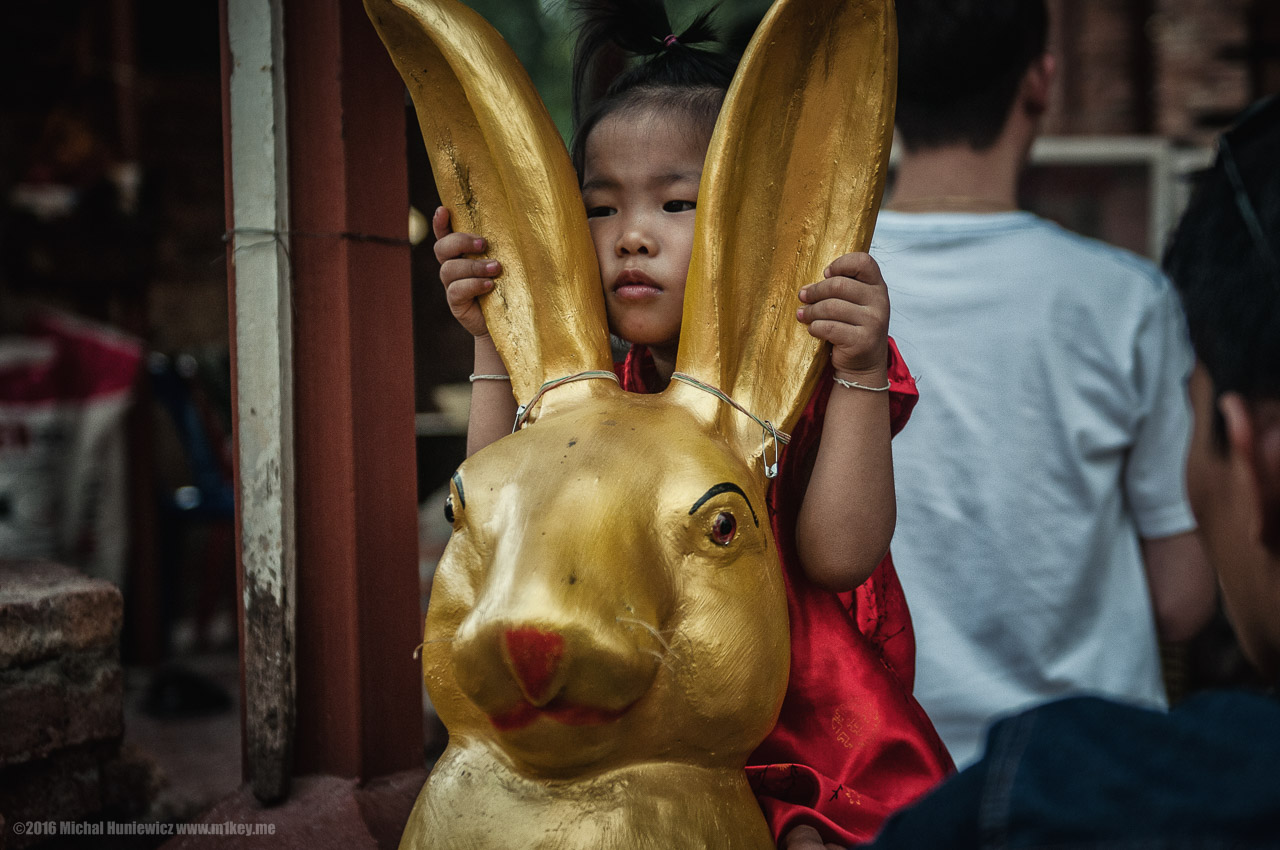
In Thailand there are five gender roles, as it turns out. That's straight (male or female), lesbian, gay, tom, lady boy. [14] We saw many lady boys and - contrary to common belief - there's no way you'd mistake them for a woman. Unless the ones we thought were women were...
ISO 200, 48mm, f/2.8, 1/1000s.
Monk Mummy
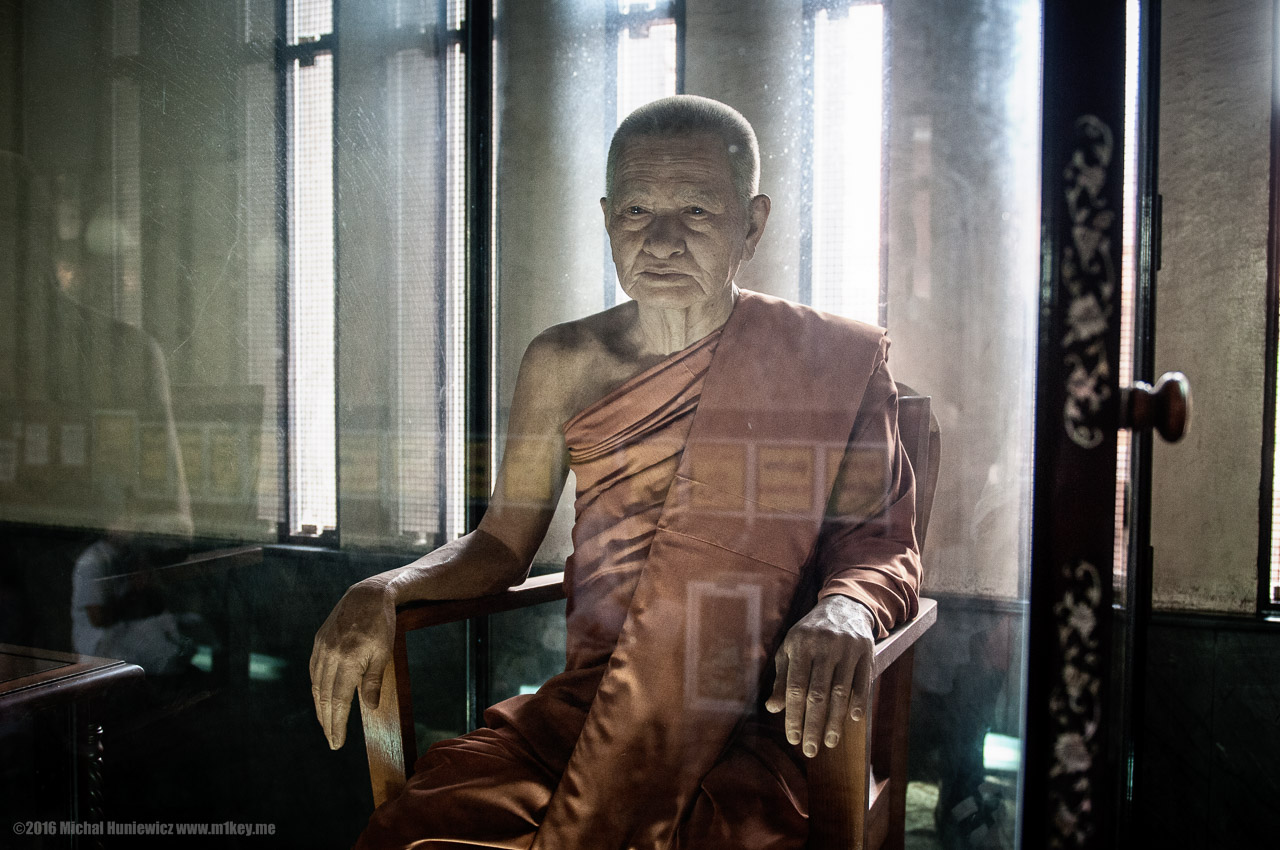
Mummy of a monk, we were told. Amazingly preserved, and that spark in the eyes!
ISO 560, 24mm, f/2.8, 1/80s.
Attaching Gold
Leaves of Gold
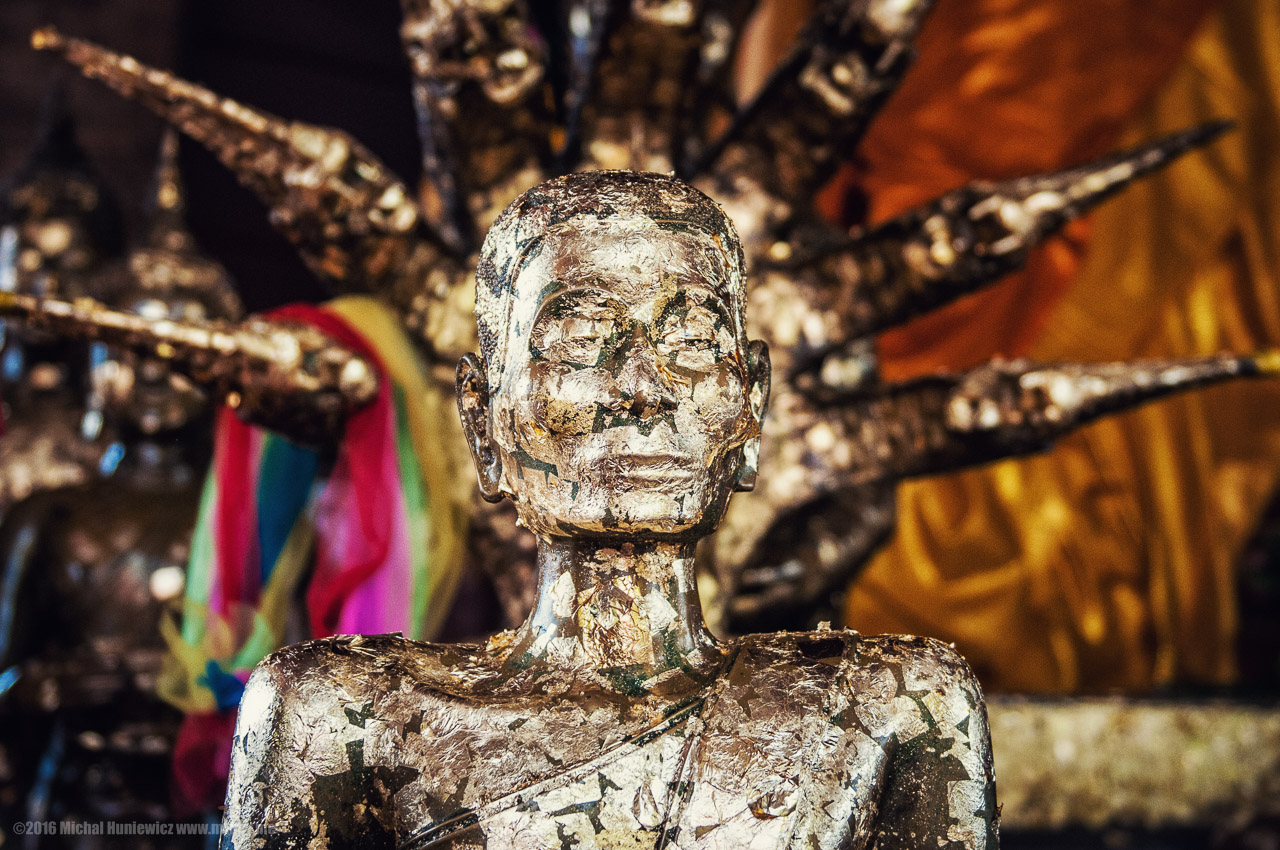
Thailand has a reputation for being a sex tourism destination and the Mecca of prostution - but China, Taiwan, or the Philippines actually have more prostitutes per capita than Thailand. Also, for those keen to blame everything on the West - national Thai men regularly seek out sex workers' services. [14]
ISO 200, 40mm, f/2.8, 1/400s.
Burning Sticks
Just Sitting There
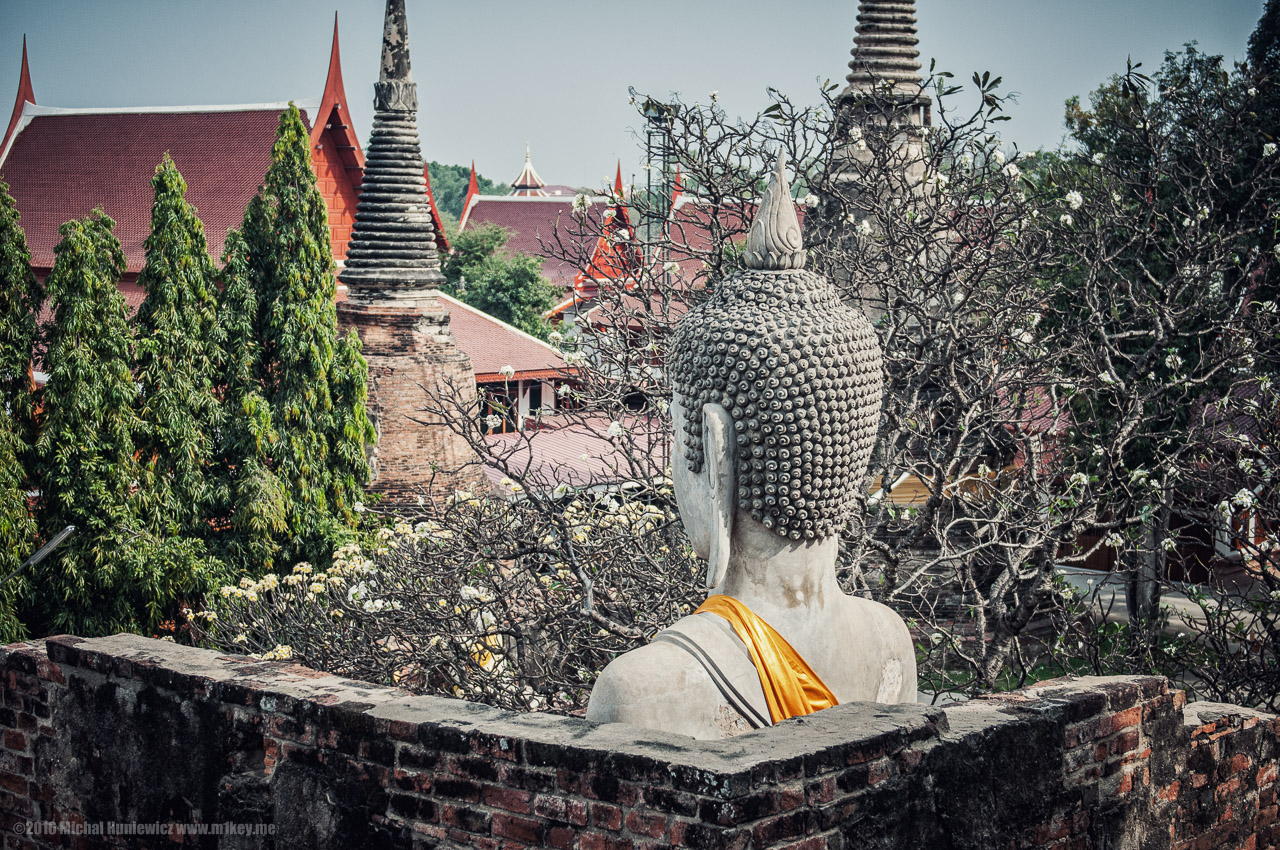
Wat Yai Chai Mongkhon. Most Buddha statues in Ayutthaya have no heads - they were removed when the Burmese invaded the city.
ISO 200, 38mm, f/2.8, 1/1250s.
Elephants
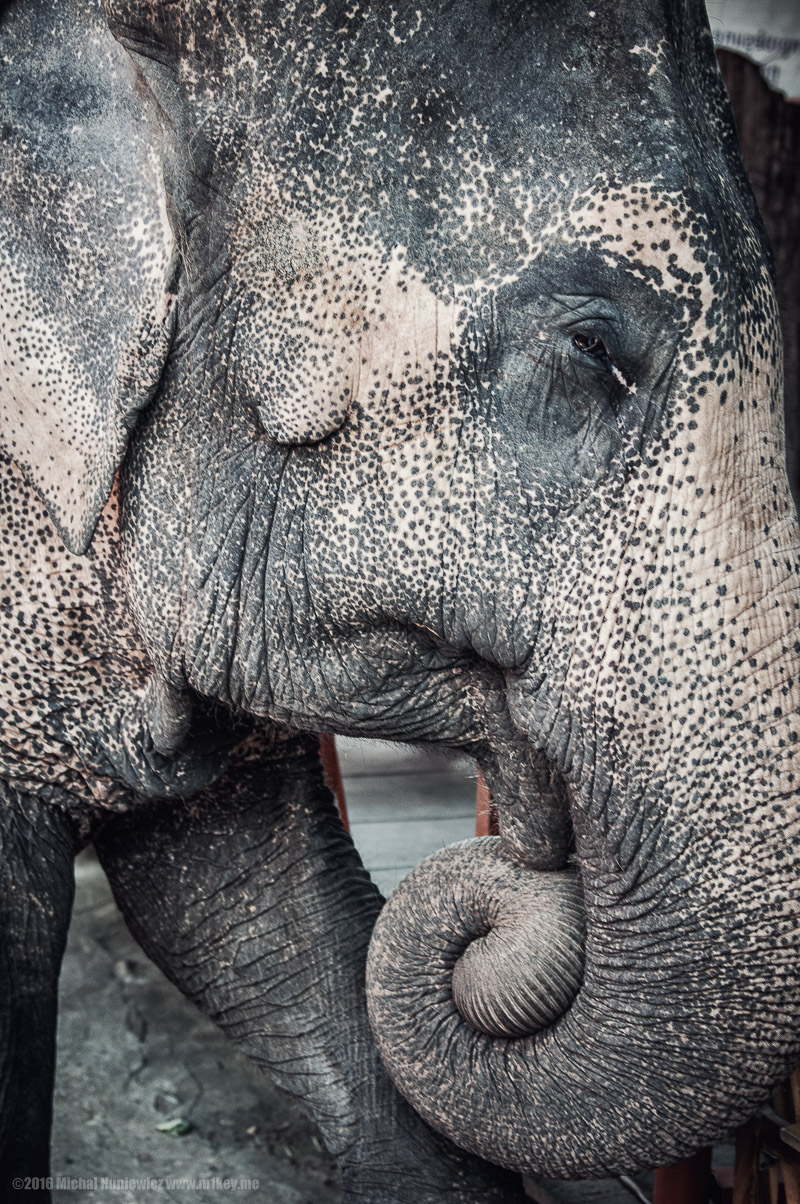
We asked the driver to be taken to Elephantstay, the place to meet and ride elephants.
ISO 200, 32mm, f/2.8, 1/160s.
Chain
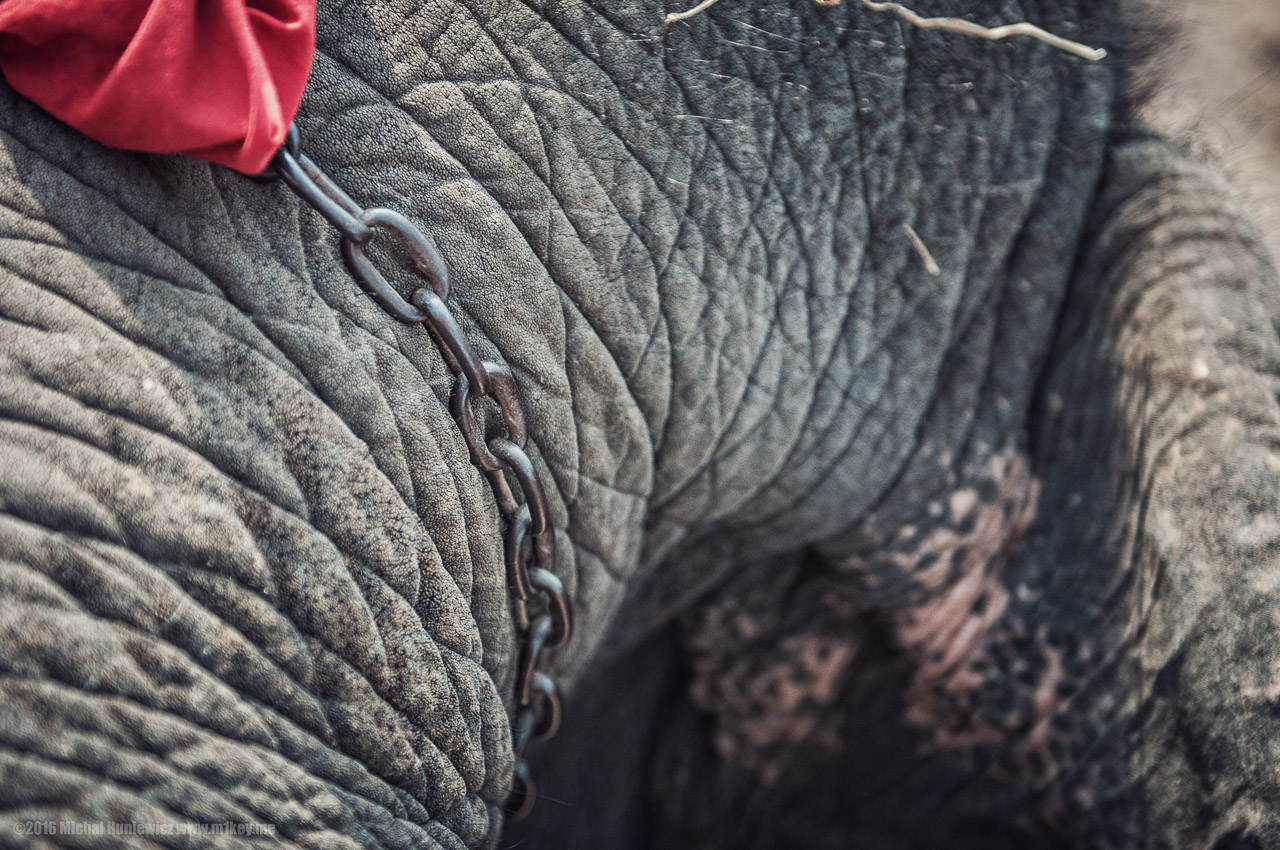
But it was a scam. We were taken to Ayothaya Elephant Village instead - a somewhat disturbing place. Elephants yelled at or chained to the ground in a pretty crowded place.
ISO 200, 56mm, f/2.8, 1/400s.
Ivory?
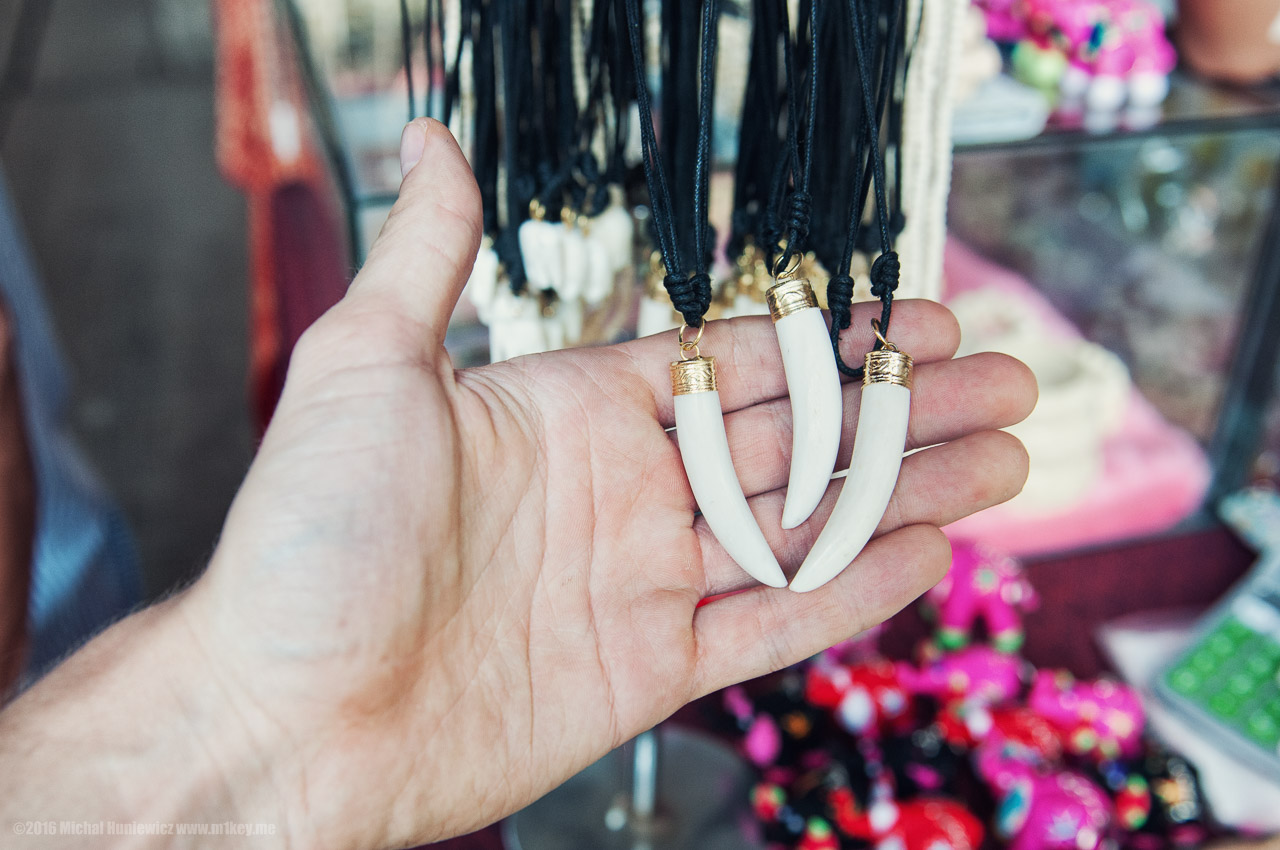
As we were leaving, I noticed these - they told me it was ivory... I advise everyone to avoid that place which doesn't seem to have a lot to do with elephant care.
ISO 200, 24mm, f/3.5, 1/60s.
Leaning Tower(s)
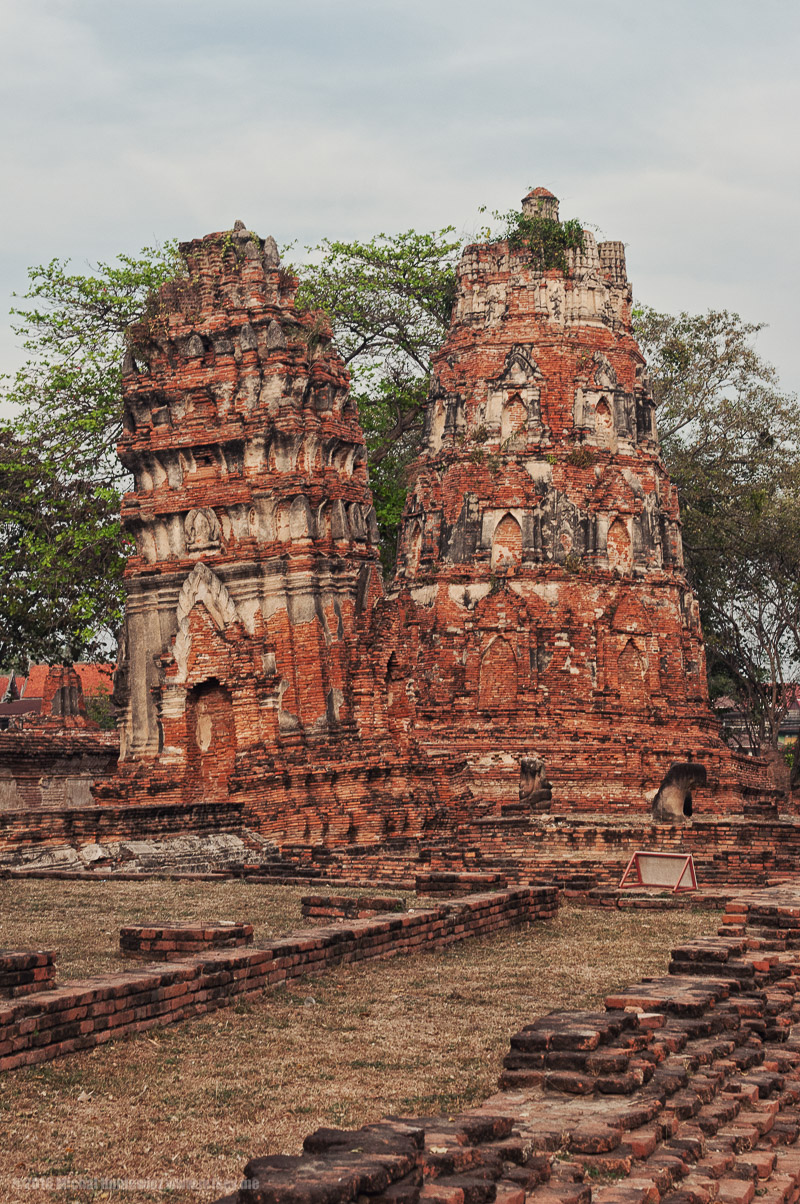
Do you rememebr the full name of Bangkok (above)? That's right, Ayutthaya got sacked and has never recovered since. There are many temples all over the city, and many of them are ruined, like this one.
ISO 200, 48mm, f/8.0, 1/125s.
Dog
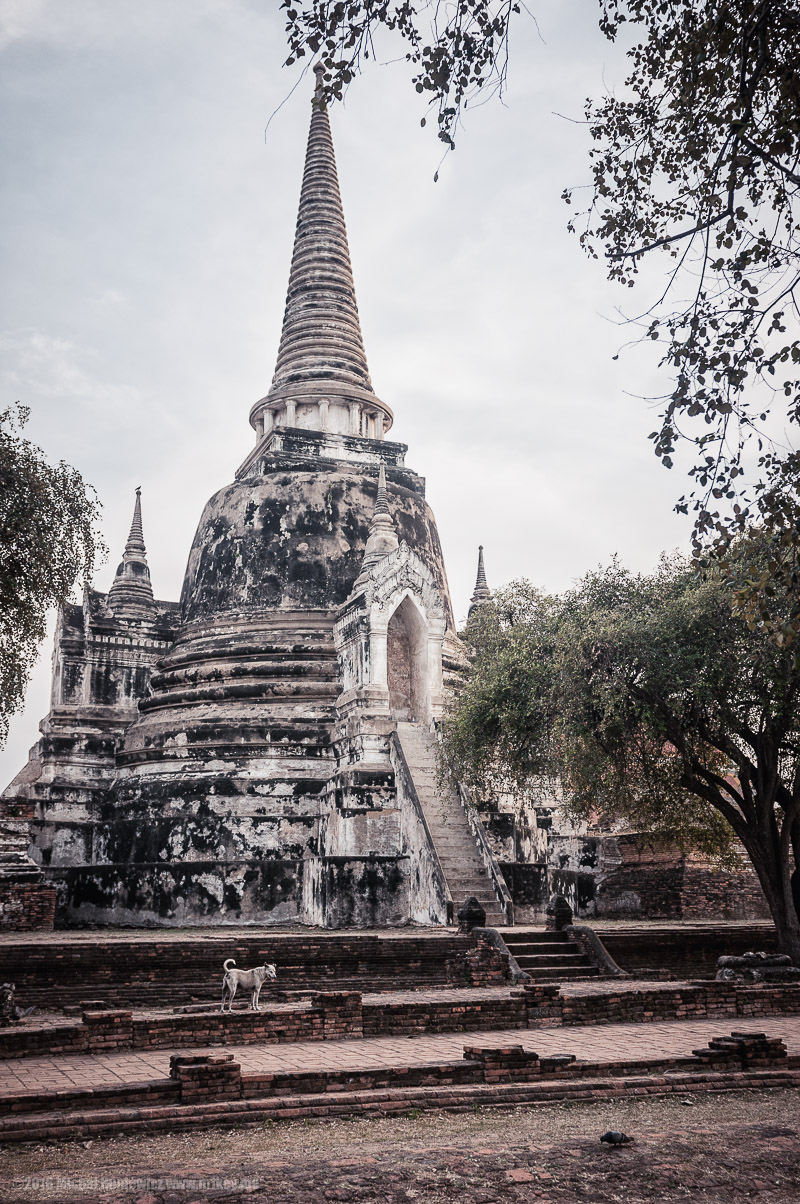
The doors to the stupas are bricked up, and friendly dogs seem to run the place.
ISO 200, 24mm, f/4.0, 1/160s.
Face of Buddha
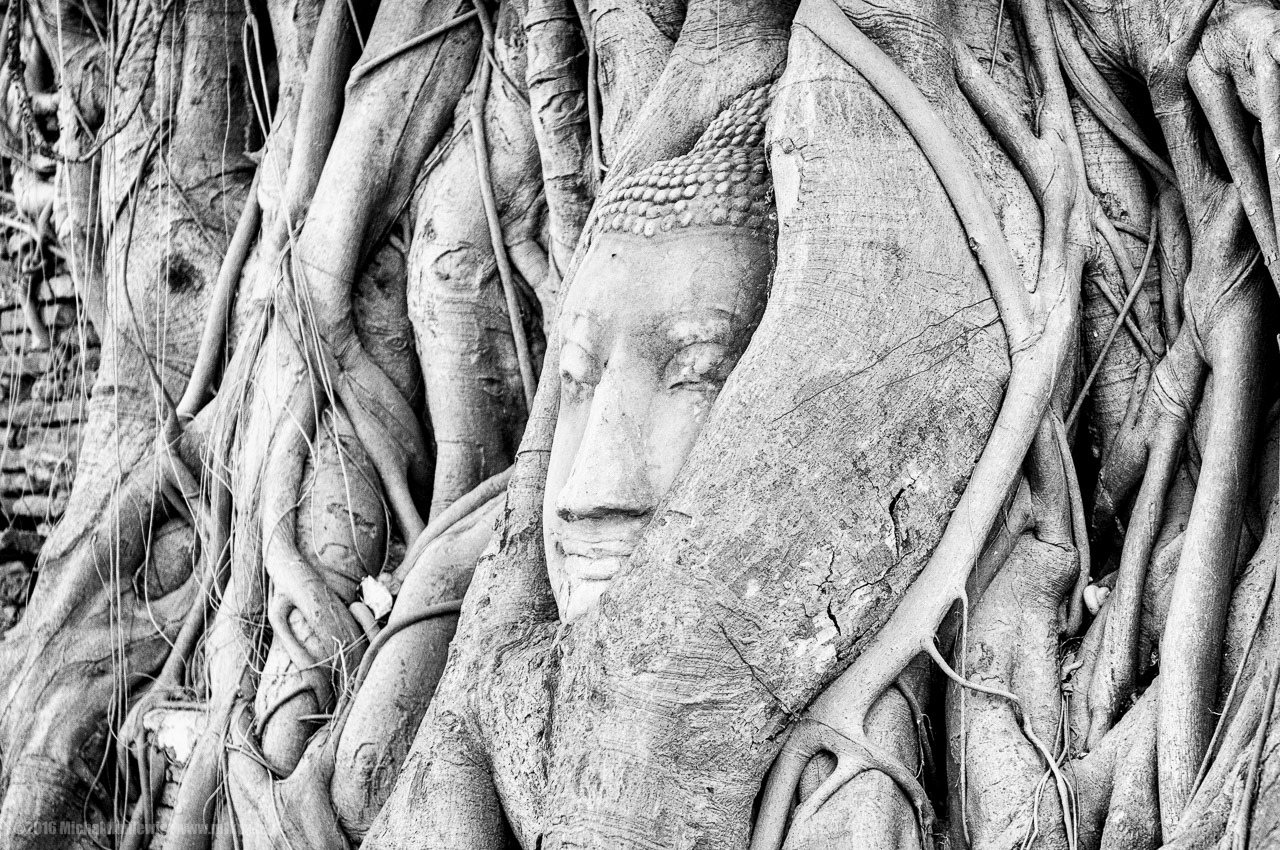
And then we found it! Here was the face I was looking for, in a former capital of the Kindom of Siam, Ayutthaya.
ISO 200, 58mm, f/3.2, 1/100s.
